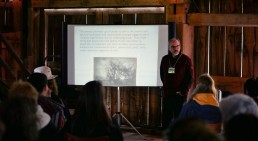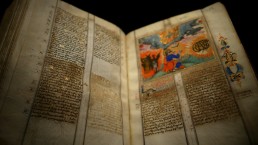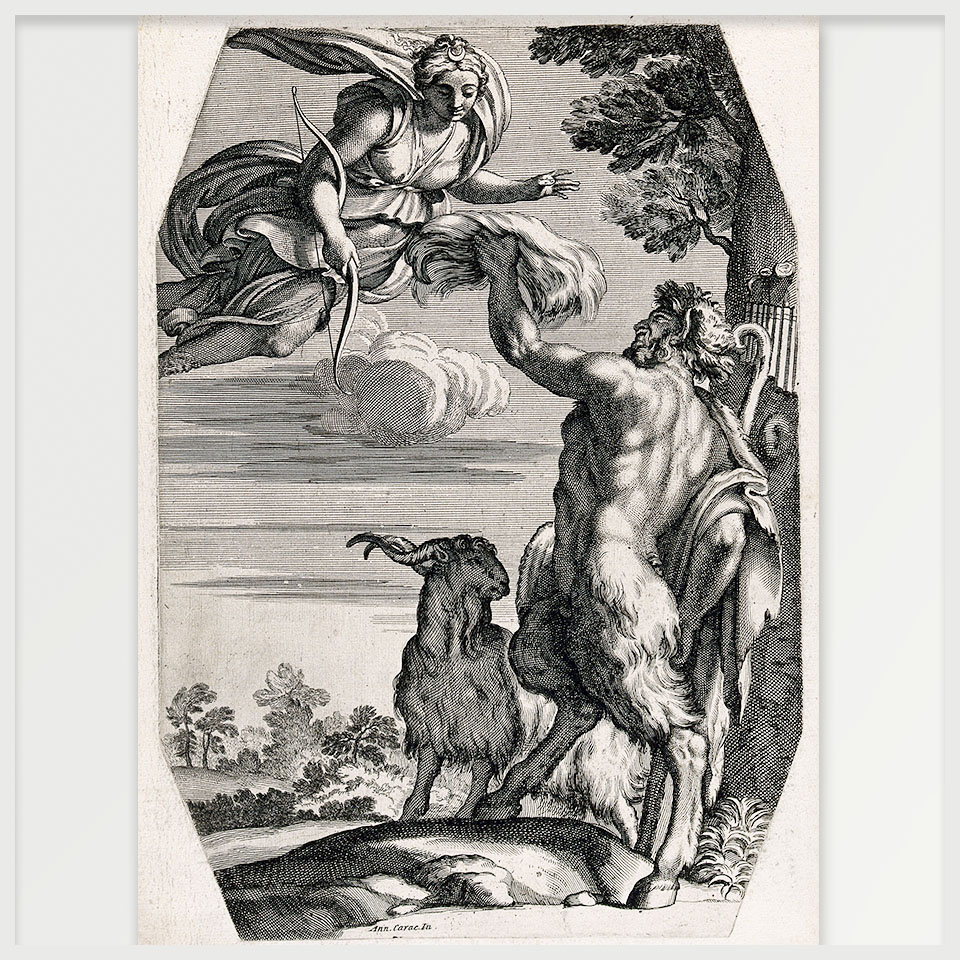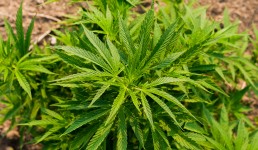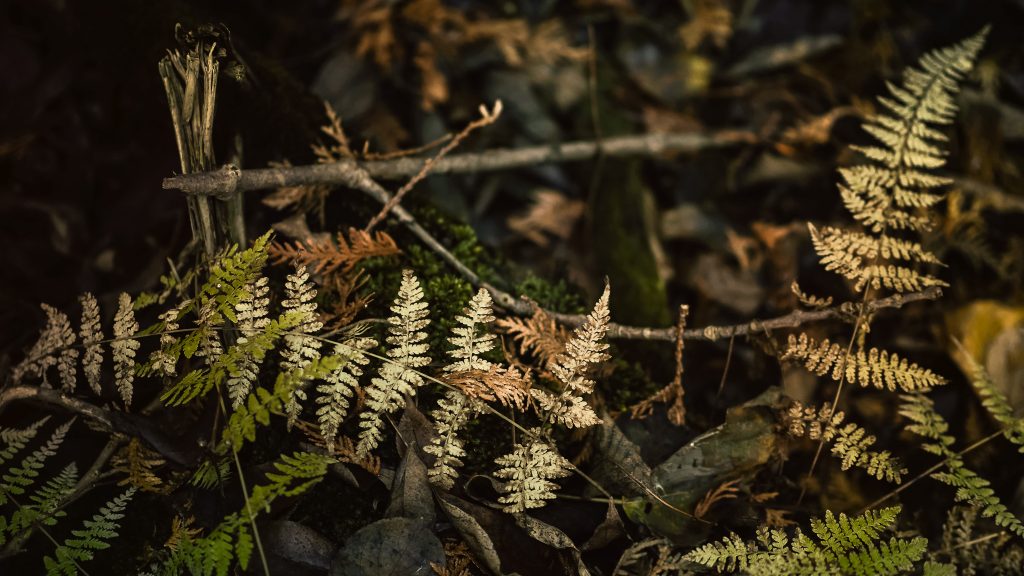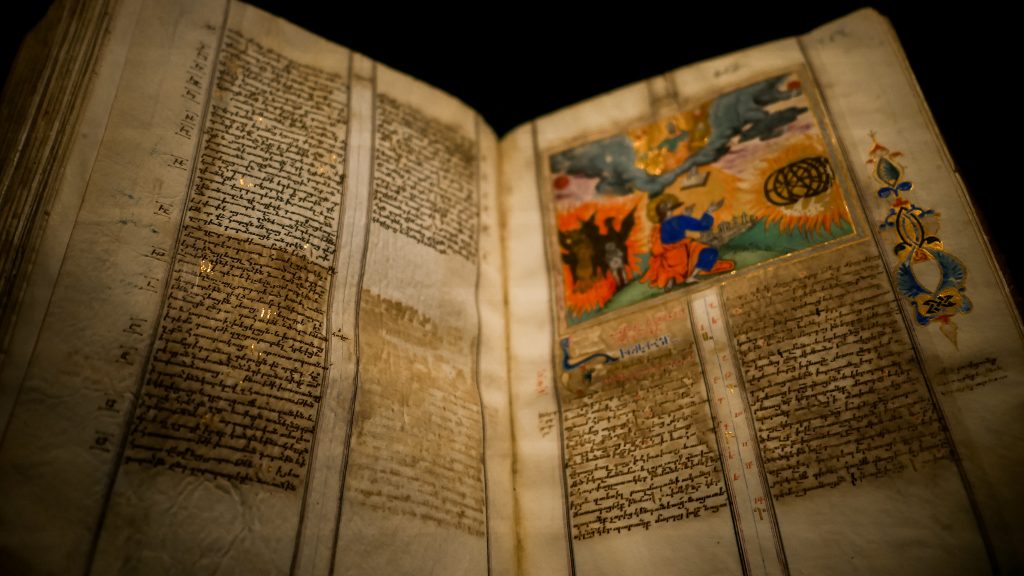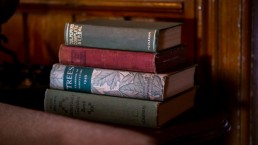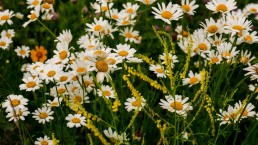An Interview with David Winston
This interview was conducted as part of Everything Herbal’s ‘Herbal Elders’ series. This series seeks to honour and explore the unique contributions of longstanding members of the herbal medicine community in Canada, as well as abroad.
This interview was originally conducted with Nick Faunus, Penelope Beaudrow and Victor Cirone, in July, 2022.
Reciprocity in herbal medicine
Everything Herbal: I’d like to begin our discussion by considering the place of reciprocity in herbal medicine. What can you tell us about this?
David Winston: Let me start off with a story and introduction. This year I’ll have been studying herbal medicine for 53 years. I started studying herbal medicine in 1969 and at the time all of my friends were interested in one herb, and I was interested in all of the others. Fascinating how today the interest in that one herb has grown tremendously, but I’m still primarily interested in all of the other ones. In 1969 there were no real herb schools, it was hard to learn about herbal medicine. People would say to me what do you do? I would say I’m an herbalist and people would look at me like I was an alien from another planet coming to abduct them. Why would you waste your time with something people did 100 years ago? I fell in love with plants and herbs, with being able to walk out in the woods and the fields and find medicinal and edible plants. My early learning came from a number of sources. Some of it came from books, I would read any book I could find on the topic, and at the time there weren’t that many. One of my first books was ‘Stalking the Wild Asparagus’ and then ‘Stalking the Healthful Herbs’ [both titles by Euell Gibbons] and ‘Back to Eden’ by Jethro Kloss. In reading these books, I was being handed knowledge of the generations, knowledge of our ancestors. And then I started looking for people that I could learn from. And it was difficult. I took a couple of classes from Dr. Christoper probably in the early to mid 70s. One of my friend’s fathers came to America from Germany and was really into organic gardening and farming, which he taught me. I had another friend in high school whose mother had studied Chinese cooking. I knew how to bake and we taught each other. This is one of the things that initially peaked my interest in Chinese herbs, learning to use them in a culinary way.
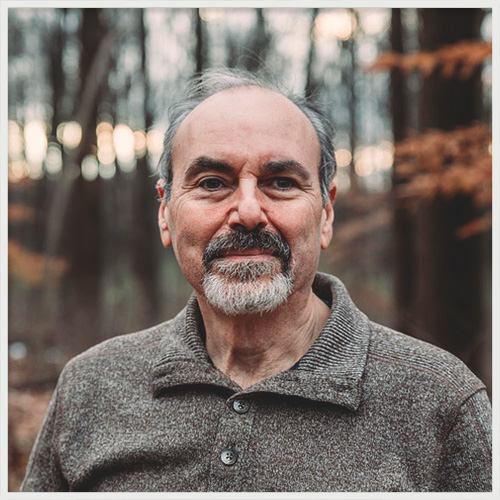
Reciprocity was built in – the fact that much of what I learned early on was not necessarily from a school where I was paying for the information. I remember one time we went to the World’s Fair in Montreal when I was a kid. My parents decided we were going to go for a little vacation up into Northern Quebec. It was a memorable trip. This was at a time when there was a fair amount of anti-English sentiment, which we didn’t know about until we arrived there. My mother did speak a little bit of high school French, but not Quebecois. Most of the time we would go into places and they wouldn’t talk to us. It wasn’t a question of whether they understood English or not, because as soon as they recognized we were English speakers they ignored us entirely, like we weren’t even there. We went into this one store, a general store, and they had horehound candies. I had never had horehound before, but I had read about it. So I had to get them. I put one in my mouth and within 10 seconds I spit it out, it was the most disgusting thing I had ever tasted in my life, or so I had thought at that moment. Interestingly enough, an hour later I wanted to try another, which I was able to keep in my mouth for 30 seconds. And by the end of the day I liked them. It was a gradual process of getting acclimated to the flavour. The guy at the counter noticed I bought these and was trying them, and he said to me in English, ‘are you interested in plants?’ I told him that yes, I was deeply fascinated. He started telling me about his favourite herb, a plant he called black snakeroot. I had no idea what it was he was talking about, he didn’t know any Latin binomials. He had a little bit of this herb, let me smell it and gave me some to taste. Many years later I realized that what he called black snakeroot I would call wild ginger, Asarum canadense. It was one of those experiences of recognition and generosity, facilitated by the plants. This happened even though I spoke English and he primarily spoke French. What made the breakthrough was plants.
I feel so fortunate to have been studying herbs for 53 years, and to have been in clinical practice for 45 years. I’ve got to spend almost my entire life in this community of people who love plants. For a very long time I thought I was the only herbalist in the entire Eastern US. It turns out I was wrong, but the majority of the other herbalists who I later found out about were often folk herbalists in rural communities, well known in their own communities but not beyond that. People like Evelyn Snook in central Pennsylvania, or Catfish Gray in Virginia, or Tommy Bass in Alabama. There were other herbalists too, they just weren’t particularly well known. I grew up in Maryland but we had moved to New Jersey, and there was a woman in Rahway, NJ, Henrietta Diers Rau, who I never got to meet but I found her wonderful but somewhat obscure book, ‘Nature’s Aid’ in the library. Henrietta trained at the British School of Phytotherapy in the UK, she was a practicing herbalist, not very far from where I lived. Some years later, in 1981, the first major US herb conference took place in Breitenbush Oregon, organized by Rosemary Gladstar and California School of Herbal Studies. At that time I was the only herbalist there from east of the Mississippi river. I remember sitting in this large room, in a semi-circle with 69 other people, sitting on the floor, looking at all these faces and realizing: these are my people. It was such an incredible experience to feel a part of something.
“…So many herbalists live truly inspired lives”
If we go back 40 or 50 years, being a herbalist was not something that was widely known, appreciated, or in any way accepted. If you told your high school guidance counsellor that you wanted to become a herbalist, they would have looked at you like you had lost your mind. The reality is that people who took up this work were very isolated, but eventually as we got to know each other, we found out there was an amazing community of creative, curious and interesting people working with plant medicine. So many people in the herbal community were multifaceted and amazingly talented. Our herbal elders, some of whom are no longer with us. Michal Moore, for instance – he was a classically trained musician, and performed on wind instruments in the LA symphony orchestra. Michael Tierra is a concert pianist. Jillian Stansbury is a polymath, she is brilliant in so many ways; she is a musician with an incredible voice, and for fun in her spare time she studies things like quantum physics. It is such an interesting group of people: poets, artists, musicians, as well as herbalists, and I think that speaks to the heart of many herbalists, to the fact that so many herbalists live truly inspired lives. Nobody gets into herbal medicine because they think they are going to become rich and famous. That’s not the motivation. There are people who become well known and make a good living, but that is not the underlying motivation. To a great degree, people fall in love with plants and with the idea of helping others, and that is the real motivation.

Even though I’m not in full time practice anymore I still see patients. I haven’t charged people for helping them since sometime in the 1980s. I just help people. It seemed it was not right to charge people to make money off of their suffering. I’m not trying to suggest that it is wrong for others to charge for their services. My income comes from teaching, writing books, consulting with physicians and industry. When somebody comes to me and they say ‘I need help’, I just help them. For me that is a big part of reciprocity. So much of what I have learned over half a century was shared with me freely and I love sharing it with other people. Whenever I can, and whenever people are interested I’m always happy to share what I have learned. You know the old expression: we stand on the shoulders of giants. It’s true. So much of what I know comes from traditional Chinese medicine, from Southeastern traditions in America, the Eclectics, the Physiomedicalists, from the practices of Ayurveda and Unani-tibb. These traditions are 100s or even thousands of years old. They all inform what I do and what every other herbalist does. Nobody discovered all of the things that St. John’s wort can do by themselves. It has been a gradual process of disclosure taking place over millennia. As we use herbs in clinical practice, we gain unique insights and share them and our collective knowledge just continues to grow. This too is reciprocity. I see so much of this in the herbal community: reciprocity, generosity, creativity. And those are wonderful things to have as a foundation for a community of people who are in most cases trying to make a difference in the world by making people’s lives better.
Accomplishments in the world of herbal medicine
Everything Herbal: What would you identify as some of your major accomplishments in the world of herbal medicine?
David Winston: The greatest thing that I personally have done as a herbalist is in the area of education. As a practitioner, there are a lot of people I have worked with and helped. Sometimes people say: ‘you’re a healer.’ I’m not, the herbs are the healers, the Creator is the healer, I’m not a healer. At best, I’m an educator. Whether I’m educating on a one to one basis in my role as a clinician or educating students about the wonders of herbal medicine, it’s a deeply fulfilling role. I may be giving an herb walk and sharing with people who may have never been exposed to herbal medicine before, or lecturing to my two year herb studies program, where thousands of people have studied. The program is designed to teach people to become clinical herbalists. Half of the students who come into this program are already medical professionals, MDs, NDs, DOs, nurse practitioners, acupuncturists, veterinarians, and other health care professionals. The other half of my students are people who have been self studying herbal medicine for years or even decades and they really want to improve their skill level so that they can help people in more profound ways. Adding herbs to your toolbox, so to speak, makes a huge difference. It’s not that herbs can do everything – they can’t. But where herbal medicine is strong tends to be where orthodox medicine is weak and vice versa. When I say herbal medicine, understand that in my view herbs are not foundational. What do I mean by that? The foundations of health are a healthy diet, adequate good quality sleep, exercise, healthy lifestyle choices, and stress reduction. Those are the foundations of health. Any herbalist or any practitioner of any sort that is not working with all of those things is missing the boat. Nobody ever became sick because of St. John’s wort deficiency. The idea is that we want to do everything we can to help people. We start with the foundations of health, and when we get to therapeutic modalities herbal medicine is incredibly useful. Most herbs are relatively nontoxic, there is a fairly low rate of clinically significant adverse effects especially if you know how to use herbs appropriately.
“It is more important to know the person who has the disease, than the disease the person has” – Hippocrates
In my first two year herb studies program I had two students. That was in 1981. I was thrilled that anybody else wanted to learn about medicinal plants. Today we have students from all over the world. My goal in teaching people is not to teach them to be good herbalists; my goal is to teach them to be great herbalists. When I say great I don’t mean as a comparison to someone else, I mean each person in their own unique way. Each of us is capable of greatness based on our unique knowledge, intelligence, skillset, passion, creativity; each of us has the ability to take this information and do unique and wonderful things with it. But I also believe that if you really want to be a great herbalist, then there are a few things you have to understand and the first thing is to stop focusing on treating disease. Hippocrates is believed to have said more than 2000 years ago: “it is more important to know the person who has the disease, than the disease the person has”. He was right then and he’s right now. What he means by that is if you have 5 people, all diagnosed with rheumatoid arthritis, the treatment for each will be based upon their unique requirements as individuals. From an orthodox medical perspective the treatment for a given disease seen in different individuals is often the same. As an herbalist, I look at 5 unique people. Yes they all have rheumatoid arthritis, some are female, some are male (hormonally speaking), some are old and some are young, some have underlying GI issues, some have circulatory issues, some have cardiovascular issues, and the more you can treat the person who has the disease, the more effective your protocols are by far. If you have somebody with bacterial meningitis, don’t call the herbalist, reiki healer or chiropractor. You want them in the hospital with iv antibiotics. It is not about creating a dichotomy between orthodox and complementary medicine. They both have their strengths and weaknesses. The key is helping students to understand how they can most effectively help people.
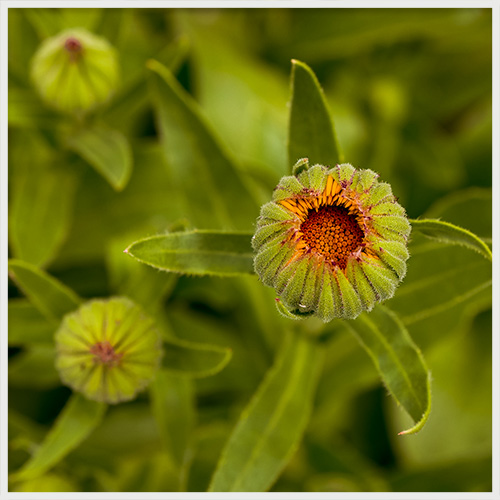
46 years ago I was introduced to the concept of energetics by one of my early teachers who in my opinion is one of the great herbalists of the 20th century: William LeSassier. William is the person who introduced me to herbal and human energetics, which allows the practitioner to match specific herbs to the person. When you focus on the disease, you are missing out on the energetics and the constitution of the patient, which is required if you are to treat the person. William also introduced me to Chinese medicine and Chinese herbs, as well as a lot of obscure western herbs like evening primrose. Everybody who is reading this is probably is saying ‘evening primrose seed oil, I know about that.’ But I’m not talking about that, which I don’t think is even all that useful. I’m talking about the herb Evening Primrose (Oenothera biennis), the leaf, flower or root bark. It is a common native weedy plant, it is an incredible medicine used for things like GI-based depression and inflammatory bowel disease, it’s a wonderful medicine that almost nobody knows about. I credit William again with changing my mind and my entire direction in herbal medicine. Before what I had encountered was along the lines of: this herb is good for headaches, this herb is good for depression, etc. You see this all of the time with these little soundbites of information about herbal medicine that get circulated in books, classes and the internet. For example, St. John’s wort is the depression herb, Saw Palmetto is the prostate herb, or Black Cohosh is the menopause herb. There is one problem with each of those statements: they are wrong, wrong and wrong.
Take St. John’s wort: when I teach on the differential treatment of depression and anxiety, we differentiate more than 14 types of depression based on the underlying pathophysiology. When you treat a person who is depressed, you need to understand what is actually causing the depression. Is it GI-based depression, inflammation-induced depression, old age- induced depression, blood sugar dysregulation-induced depression? The studies show that most pharmaceutical medications like SSRIs and SNRIs work about 40% of the time. St John’s wort also works about 40% of the time if you just give it for the disease entity depression. But if you actually treat the person who is depressed, I can say from my own clinical practice (there are no studies on this) 60 – 65% of my patients with mild to moderate depression have very significant improvements, even to the point where they don’t feel they are depressed at all anymore. This is huge when compared to 40%. Is it perfect? No, but the point is that we have a significant improvement when we are treating the person rather than the disease.
“…That we have helped to teach people how to be great herbalists, is something I’m very proud of.”
For me I think the accomplishment I am most proud of is to be able to look around and see a much bigger herbal community than existed when I first started. People who have been part of my programs are a piece of that, and to know that we have spread that information, that we have spread that knowledge, that we have helped to teach people how to be great herbalists, is something I’m very proud of. Today I look around the world and there are people who have graduated from my program who have their own schools, who are well known herbalists that have written many books, who have these incredible practices. Of course it is not just because of my program that they accomplished these things, it was just a piece of their development. But the fact that I can help people with that one piece to me is a blessing. It makes me very proud to be a part of this community and to continue to pass on what I have learned, to share it and have our traditions continue.
“In the US we spend more money per capita on healthcare than any other country in the world”
Some years ago I was the keynote speaker for a conference called the Florida Herb Conference, organized by Emily Ruff, a wonderful herbalist. I called my speech ‘I Have a Dream.’ I started off by saying ‘you’ve heard these words before by someone far more eloquent than I, but I have a dream too, and my dream is that within my lifetime I hope to see a time where almost every mom, dad, grandmother and grandfather knows basic kitchen herbalism for their family, where there are community herbalists in every community and clinical herbalists available in any clinical setting.’ Why? I believe without a shadow of a doubt, and I’m talking now about the US, (in Canada things are a bit different) in the US we spend more money per capita on healthcare than any other country in the world yet we have worse health outcomes. We are behind every developed country when it comes to infant mortality and life expectancy. We are close to the top when it comes to obesity and cancer, but in all of the health measures that you want to be good at, there are many underdeveloped countries that have much better numbers and outcomes than we do. I believe that really well done herbal medicine can help us create a sustainable practice of medicine not only in the US but around the world. There are countries like India, China, Japan, even Germany where herbal medicine is part of mainstream medicine and it allows them to have a more effective medical system with fewer adverse effects and a greater number of options. That’s my dream. That’s my goal. To make this not alternative, but a part of the mainstream, not just mainstream medicine but mainstream understanding and knowledge. I hope that at some point everybody knows basic herbs to use for common ailments. Most people already know that if you are constipated you can take prune juice or that you can use aloe for a burn. There are lots of things like that that people could learn and use at home, thereby preventing for example the unnecessary use of antibiotics. Antibiotic resistance is a huge problem today. How many times could we give somebody antibacterial herbs for a UTI and thereby avoid having to use antibiotics altogether. How many times do we see people being given antibiotics when they have a viral infection and they don’t work at all? Yet we have herbs that would be perfectly appropriate in that situation. Are herbs the answer to everything? Absolutely not. Are they an answer that can help us to create a better practice of medicine, one that is better for the planet and better for the people and animals on the planet? Without a doubt.
“As a clinician one of the greatest gifts that you can give yourself is to keep an open mind.”
Everything Herbal: I’ve been fortunate to go to many herbal conferences over the years and have heard so many speakers. Out of all the speakers I have listened to, I can still see you on our stage at the Restorative Medicine Conference. I was in the front row doing the introductions and you opened for us. You sang a song, and even though I had no idea what you were singing, it penetrated my soul and made me cry instantly. To me in that moment, and even now reflecting back after all of these years, it was a profound healing experience. I still even get emotional about it because I have no idea what happened in that moment, but I know that something happened. You were the portal for something awe inspiring to come through, and it was a great gift.
David Winston: As I said earlier, I think that the plants are the true healers but many people in the herbal world have gifts that go beyond herbal knowledge. Many are inspiring, wise, and stewards of the green world. In addition to being an herbalist, I write poetry, I sing, I garden and love photography. These things bring me pleasure and help me to see the world in a different way and express myself creatively. I always wished I was better at visual arts. Unfortunately I’m not a very good artist, although both of my parents were very good artists. I have some significant visual, hand/eye coordination issues. I was born severely visually impaired and I didn’t actually see until I was about 18 months old. I had 3 surgeries on my eyes by the time I was 5. There are certain things that I just don’t do as well as most people do. When I was a child there was no diagnosis of dyslexia, or ADHD, although I would have been diagnosed with both if I was born 15 years later. People think of them as disabilities, and they are challenges for sure. But they also bring unusual strengths and skills if you are fortunate enough to have the necessary help navigating the differences. I was talking about this before when I talked about being great in our own unique ways. I don’t consider myself great in any particular way but I am striving to be the best that I possibly can be in every single thing that I do. Now obviously I fail more than I succeed but you keep trying, you keep trying to grow and become a better person, clinician, parent, friend or partner.
As a clinician one of the greatest gifts that you can give yourself is to keep an open mind. I always tell my students the worst disease a practitioner can get is what I call “hardening of the mind”, where you start to believe that everything you know and think is true. I am partially kidding when I say this, but I always tell people after 53 years of studying herbal medicine I now feel comfortable calling myself an advanced beginner. Why? It doesn’t matter how much you know, it is still a fraction of what there is to know. You always want to stay open to the process of continuing to learn. This is true for anybody, whether an auto mechanic, a scientist, a farmer, a physician, an herbalist or an artist. It is openness to creativity, to new ways of seeing, thinking or being that allows us to grow professionally and as human beings. How many examples do we have of musicians who become famous for a certain style and their next album comes out and its totally different and their fans don’t like it. But as an artist, there is something that pushes you to grow and experiment. To stay stagnant and just keep doing the same thing over and over and over again doesn’t serve that purpose and ultimately doesn’t serve the art. As an herbalist or as a clinician you have to stay open minded to the fact that everything you believe is true is subject to change. That doesn’t mean it will change, but it could. When we get dogmatic and when we start allowing ourselves to be put up on a pedestal, we are in dangerous territory. If you are up on a pedestal and everybody is looking up at you, invariably you are looking down, its an uncomfortable place to be. Something about human nature is that while people love putting others up on pedestals, they also love tearing them down.
“… Recognize that the plants are the healers.”
It is important to stay humble, to recognize that the plants are the healers. Art, music and creativity are also great healing forces. So is vulnerability. Recently in class a student asked a question and it was about somebody going through a really hard time. I didn’t say to them ‘oh you should do this and that’; instead, I allowed the experience that was shared to touch me, just like that song touched you. The experience of suffering that was related in class touched me deeply and reminded me of an experience in my own life. It was a very humbling experience; being able to share vulnerability and fragility with others allows people to recognize and connect in to their own pain, their own suffering, their own fears, their own doubts. When we can do this, we begin to recognize that we are not alone in our sufferings, and not alone in the world. In any traditional form of medicine, there is no separation of body, mind and spirit. Of course, there are times when you have a simple wart and I don’t need to know what’s going on with you emotionally. I can simply say, ‘here try some celandine, put it on twice a day’ and more often than not the wart will disappear. But if we are talking about more serious health issues like depression, anxiety, autoimmune disease, cardiovascular disease, all of these conditions don’t just affect the body, they also affect the mind, the soul and spirit too. All of these levels are deeply interconnected, they are all part of the same organism.
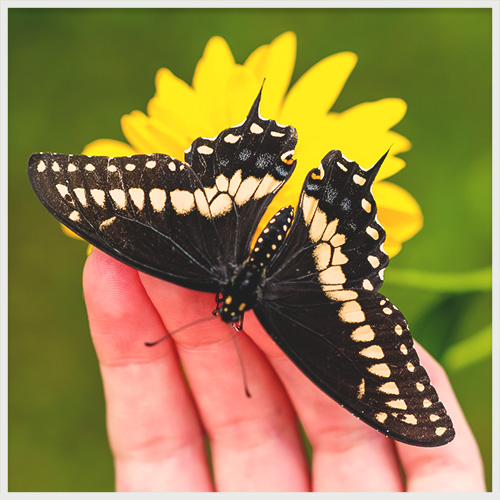
This is also where complementary medicine can fall short. There was a diagram created by Kenneth Pelletier in the 70s of three interconnected circles labeled body, mind, and spirit. That is supposed to represent holism. There is only one problem with that: it is not big enough. If you put a big circle around those three interconnected circles, that circle is family. Then there is another even bigger circle around that, and that’s community. And then there is yet another circle around that, and depending on what name you want to give it, that’s God, the Creator, Nature, Gaia, whatever concept you want to put in there. What the body/mind/spirit level of the diagram recognizes is that we are interconnected within ourselves, but what it fails to recognize is that we are also connected to everything else, to everything outside of ourselves. When I teach my class on depression, one of the things I always tell people about depression is that it can be a learned behaviour. If you grew up in a household where one of your parents was chronically depressed you stand a 50% chance of being chronically depressed yourself. If you grew up in a household where both of your parents were chronically depressed you have about a 100% chance of being chronically depressed. As an infant and young child you don’t know what is healthy behaviour and how things in the world can or should work. Whatever behaviour that is modelled for you becomes your norm. If the people around you are always depressed, always anxious then that is what you come to believe is normal and desirable.
“To feel that you have a place in the world, to feel connected is essential to health and wellbeing.”
There is also a part of the brain known as the mirror neuron network. If, for example, your significant other is chronically depressed or anxious, the chances of you becoming chronically depressed or anxious skyrockets. Why? Because this part of the brain which allows us to feel empathy, sympathy and connection to others, triggers deep feelings and emotions in us that are indistinguishable from our actual emotions. For most of us when we see somebody who is suffering and we feel it, not just ‘oh that’s too bad’, but when you really feel it ‘oh my god thats terrible’, you want to help and do something. That is the part of the brain that mirrors the behaviours of others, and if you are in a relationship or even living in a place where other people are experiencing those things on a regular basis, it is very hard for you not to respond and get pulled into that mindset, whether it is anxiety or depression or hopelessness. We are deeply affected by others, and in many indigenous traditions if somebody is ill you don’t just treat that person, you treat their entire family. The next circle after family is community, and so many of us no longer live in functional communities. We are isolated and separated, and this causes major issues for human beings, who are innately tribal. By using the word ‘tribal’ I do not necessarily mean a native nation, although that is certainly tribal. I certainly don’t mean the terrible tribalism that we have in the US: red vs blue, liberal vs conservative, etc. That is tribalism at its worst. What I mean is that we feel the need to belong. Unfortunately that seems to be one of the appeals of so many of these hate groups that are out there now. You have people who don’t feel like they belong anyplace, who feel like outcasts and feel scorned and belittled by society. Often, they find acceptance and comradery in such movements and they get caught up in a group that is bounded by hatred. To feel that you have a place in the world, to feel connected is essential to health and wellbeing. I talked about it earlier when I was describing sitting in a room with 69 other herbalists at a young age and feeling that I had finally found my people. Being able to find others who accept us for who we are, and participating in a functional, healthy community; this is unfortunately so rare in today’s world.
“You are part of something bigger than yourself”
The last circle, relating to one’s relationship to a higher power (again, whatever name and concept you have of this is fine), helps us to recognize that we are a small part of something much greater than ourselves, something that pulls us out of our ego, pulls us out of our fear, doubt, isolation, separation and out of our belief that the world begins when we are born and ends when we die. This perspective reminds us that yes, each and every one of us is sacred and blessed and yet each one of us is a speck of dust. We are both magnificent and insignificant at the same time.
This is the importance of having a spiritual practice, whether you have a religion or not. The connection to a higher power is the essential piece. If you don’t believe in an entity, you can achieve the same thing through Nature, Gaia, it doesn’t matter, as long as you believe you are part of something bigger than yourself. That is a really useful and helpful orientation for human beings to have; it is arguably what allows us to become human beings in the first place. If you ever go some place where there is almost zero light pollution, and I’ve been to places like this in the mountains of North Carolina or in parts of Canada, New Mexico, Maine Ireland and Costa Rica, and you look at the night sky it can be breathtaking. Instead of seeing a few bright stars or planets, you see the entire milky way. Sadly many people have not had this experience today. When you look up at such a sky it is magnificent, you enter into a state of awe. It makes you feel so small but at the same time connected to something so vast. To me that is the power of healing, those moments that literally take your breath away where you’re just in awe that the world is so magnificent, so beautiful. For many of us that experience is so far away from our daily lives, and we lose sight of it, we lose sight of the joy and the newness and the discovery and the wonder of the world that we were born with as children. For many people today, the world is not a place of wonder. It is a place of fear, hurt, prejudice, or inhumanity. I think that herbs, nature, meaningful ritual, forgiveness, compassion and love can contribute to the healing this core wound of disconnection that many of us suffer from today.
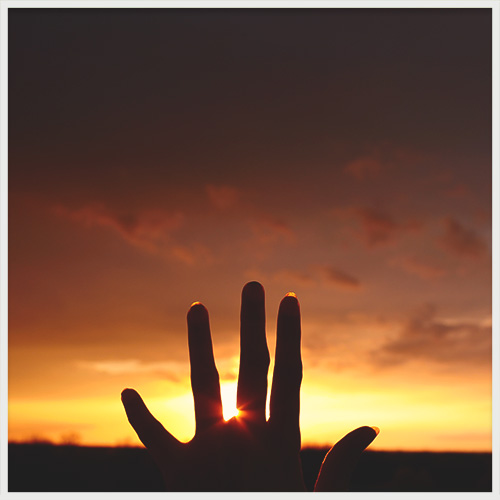
“Originally I was going to be a farmer…”
When I was in high school I used to have an organic farm. It started off as a 20 or 30 by 80 foot plot and eventually I got more land down the road. I had two acres and a roadside stand where I sold organic vegetables in the summer, in the late 60s and early 70s. Originally I was going to be a farmer, I was growing herbs and vegetables, and the one thing I didn’t grow was flowers. I thought who cares about flowers. Today I realize I was mistaken. While I still grow many herbs and vegetables, today I love flowers. And three of my favourites are fragrant roses, irises, and peonies. The irises I grow are old fashioned fragrant irises. The modern ones often have no odour, but the old varieties are really fragrant and they almost smell like a combination of cinnamon and bubble gum, a very unusual combination. Every year, when the irises start blooming I go out every single day and stick my nose in those flowers and just inhale deeply. Think of it as primitive aromatherapy. When the peonies are in flower, I go out there and I smell them too. The roses start blooming before any of the others and continue blooming in through the autumn. When I go out and smell these flowers I am so uplifted by their odours. Yes the night sky in a place where there is no light pollution is spectacular, but smelling a fragrant rose is also magnificent. Smelling one of those fragrant irises is magnificent. Magnificent things, healing things can be huge things that literally stop you in your tracks, as well as little things that for a moment bring you back to a place before you were weighed down with all of your worries, to a simpler, better place of healing.

Let’s talk a bit more about the integration of herbal medicine with the conventional medical system…
Everything Herbal: …It’s an important issue that many people don’t think about in a lot of detail. It seems like such a distant possibility. What are some ways that this might come about? What are some steps that practicing herbalists can take to do what is necessary to get to a point where the practice of herbal medicine is widely accepted, integrated, and thereby helping a greater number of people?
David Winston: Often in the herbal/alternative/complementary medicine community there is an attitude of us vs them. Tribalism, not the good kind. The mentality is that the medical establishment and the pharmaceutical industrial complex are out to get us. Granted, pharmaceutical companies are not big fans of herbal medicine because it certainly cuts into their profits. Between 1995 – 1998, many of the big pharmaceutical companies jumped into the herb market and came out with their own lines of herbal products. Within a few years they all dropped it, they realized there was simply not enough money to be made no matter how good their products were. It wasn’t close the level of profit that they got from their pharmaceutical medicines. It is true that orthodox medicine is not necessarily open to herbal medicine, but my belief is that mostly what we are dealing with is a lack of knowledge. Doctors go through this incredibly rigorous training over so many years, and when they graduate they have limitations depending on what state in the US they are practicing in. There are regulations, as well as insurance and liability issues, that keep people in their own little silos. Firstly, if we are to think about this issue, education about herbal medicine is vital. During the period between 1995-1998 herbs were hot and they were in the media all of the time. I was getting 4 or 5 phone calls a week from physicians saying ‘you know I’m interested in these herbs, I want to learn more about them.’ The media has this tendency where if something is wonderful then eventually the pendulum turns and it becomes something of suspicion. And sure enough, around 1998 we started seeing all of these articles both in the medical literature and in the popular press about herbs being dangerous.
“…One of the things that happened was that more people who were taking pharmaceutical medications were taking herbs simultaneously.”
With the increase in the use of herbs during this period one of the things that happened was that more people who were taking pharmaceutical medications were taking herbs simultaneously. There were legitimate reports of problems like herb-drug interactions and adverse effects. For example, St. John’s wort, which is a very useful plant for many different health issues, but is also the “poster child for herb-drug interactions”. That is because St. John’s wort not only affects phase 1 liver detoxification via the CYP1A2 and CYP3A4 and CYP2D9 pathways, which are enzyme isoforms that the liver uses to metabolize and break down pharmaceuticals as well as environmental toxins. It is also because St. John’s wort affects phase 3 detoxification, which takes place in the kidneys and the bowel, via the p-glycoprotein (P-gp) drug transport system. The fact that St. John’s wort up-regulates and/or down-regulates both of these systems means that it can have a significant potential for interactions with some pharmaceuticals. The good news is that, with the exception of St. John’s wort and a handful of other herbs, herb-drug interactions turn out to be fairly rare and clinically significant events, meaning they can cause a dangerous interaction, are actually even rarer still.
This is not to say herb-drug interactions can’t happen, because they can, but the danger in most cases is overstated. When looking at herbal safety if we look at statistics, taken from American studies, the number of deaths from properly prescribed pharmaceuticals (not including overdoses) is between 95 to 120 thousand people per year. The number of Americans who die from over the counter, supposedly safe NSAIDs, is 17 to 18 thousand per year. The number of Americans who die every year from food, everything from food poisoning to choking to anaphylactic allergic reactions, is about 9 thousand. These are somewhat older statistics, they could have gone up or down a little bit within the last decade. The number of Americans who die from herbs, in the last year that we have any information about this, was 37. That was before Ephedra was banned, and almost all of these deaths were from Ephedra. Is this to say that herbs are entirely safe? They are absolutely not. But this statement needs to be put into perspective.
“We can divide herbs into three categories: food, medicine, and poison.”
Your food herbs are generally safe, unlikely to have significant adverse effects and they can generally be used in significant quantities. These are things like blueberries, cinnamon, ginger and garlic, but also mild gentle herbs like lemon balm, chamomile, hawthorn berry, etc. We are not talking about allergies, because with German Chamomile there is a report in the literature of a person who had very severe ragweed allergies having a cross-reactivity reaction to chamomile, developing anaphylaxis and dying. There is one case in the entire literature out of millions of cups of Chamomile being drunk every single day. For that one person Chamomile was not safe, but anyone can have an allergic reaction to any food, any drug, any herb, any cosmetic so that is a separate issue. Your medicines on the other hand are stronger acting, they are to be used with more knowledge and usually for a limited period of time. These are herbs like Goldenseal or Ephedra back before it was banned. You don’t just take these everyday because they are good for you. You take them because you have a specific medical issue usually under the guidance of a trained clinician. And then finally your poisonous herbs should be left alone and only used by clinicians who are trained to use them, they have the potential for overt toxicity. We can think of digitalis, for instance.
Understand that what we need to do is to really educate people, not just mom and dad, grandma and grandpa, but the medical profession as well. Medical doctors don’t get much if any training in herbal medicine. I do teach at a couple of medical schools, where they get a one class introduction to herbal medicine but even that is the exception. Most physicians have no information, and what they are reading in the literature often contains a lot of incorrect information. The literature is often based on fear, many of the purported herb-drug interactions are based on in vitro studies meaning it is done in a test tube or petri dish and those rarely pan out when we start doing in vivo studies (in a living organism). Then there are many things in the literature that are a single case reports, meaning one person took something and had a bad reaction to it. If that was a pharmaceutical that would never get into a journal. That happens all of the time and you cannot ascribe causality to someone taking something and having a reaction. The reaction could have occurred for many reasons, or it could be an idiosyncratic reaction. If it is an herb that someone has a reaction to however, that will get put into a journal. Then it becomes part of the literature, and it reinforces the view: ‘oh, see herbs are dangerous.’
“Where herbs are strong tends to be where orthodox medicine is weak and vice versa.”
As I said earlier, where herbs are strong tends to be where orthodox medicine is weak and vice versa. If you have someone with chronic skin problems who has been to 20 dermatologists and nothing helps, that is one of the places where herbs shine. If you have somebody with treatment resistant mild to moderate depression (severe depression is very treatment resistant no matter the approach), who has been given various SSRIs and they didn’t work or caused significant adverse effects, herbs can work beautifully there. Herbs are not only effective in many cases for prevention, they can be used in treating many issues where orthodox medicine offers few options. There are some major issues in medicine today, one of them I mentioned earlier is drug resistant bacteria. Most people have no idea that there are studies showing dozens and dozens of herbs that can be given with an antibiotic and it shuts down the multiple drug resistant (MDR) pumps in the bacteria allowing the antibiotics to become effective again. Herbs can work incredibly well in conjunction with orthodox medicine. The more we can get out there and educate people and share this information the better.
I would like to point out though that there are many issues holding us back in the herbal community. One is that most of us don’t know how to do research. As herbalists we need to learn how to do simple, basic but good research and start publishing the results. What happens in your office is interesting but that is empirical, it is not proof. In addition to herbalists learning how to do research, herbalists need to stop thinking in a silo and start reaching out to other practitioners. Throughout my entire career, I’ve always worked with other practitioners. I act as a consultant to over 100 medical doctors and naturopathic physicians throughout the US, Canada, and Europe, and I love that relationship. I learn new things all of the time in this role. I don’t have the answers to everything and they don’t have the answers to everything, so that kind of cooperation creates movement, it helps get the knowledge out of the silo into the mainstream.
“We need to start having a better dialogue within our own community.”
One last thing I’d point out about the herbal community, there is often a significant lack of consensus about what things mean. I remember Rosemary Gladstar saying ‘the only thing herbalists agree on is not to use aluminum cookware.’ She was basically right. One of my books is called ‘Adaptogens: Herbs for Strength, Stamina and Stress Relief’, the second edition came out in 2019 the first in 2007. There were several reasons I wrote the book. One is that I got tired of people calling herbs adaptogens that aren’t. I also thought it was really inappropriate that people were using this term adaptogen to mean whatever they wanted it to mean. I had someone ask me ‘why do scientists get to decide what an adaptogen is?’ It’s because they created the whole idea and concept! The word and concept of adaptogens didn’t come from TCM, or Ayurveda, or from the herbal community – the concept of adaptogens came from Soviet research starting in 1947. They get to define the concept because they came up with it. Adaptogens are not the same as a rasayana in Ayurveda, they are not the same as qi tonic or kidney yang tonic in TCM. There is some overlap, but an adaptogen is its own thing. There is a lot of sloppiness in my opinion especially when it comes to nomenclature and terminology in the herbal community. 10 herbalists will give you 10 different definitions of an adaptogen or even worse, an alterative. If we can’t even communicate amongst ourselves, if we can’t create a consensus about what our terminology means, it becomes very difficult to communicate to someone outside of the herbal medicine world. We need to start having a better dialogue within our own community. I’m not suggesting that we become homogenized in our thinking, I don’t mean that we all have to use the same herbs in the same ways. I’m not talking about standardization. But we do at least need a consensus on terminology, I believe this would be a very useful thing.
The funny thing is that with adaptogens, there are only 8 or 9 herbs that are actually well researched and fit the definition. There are another 5 that I’d call probable adaptogens, the evidence is weaker but suggests they may well be adaptogens. And then there are another 12 or more that I’d call possible adaptogens, where the evidence is actually very weak. As herbalists we need to up our game and come out and say ‘we have something worth knowing about’ instead of just sitting there saying ‘I’m just going to do my own thing.’ Anybody who is an herbalist knows they have something of value to share, so let’s make the work we do stronger, let’s continue to educate ourselves, let’s grow our knowledge, our community, and then bring it out into the world and say: ‘here is this incredible gift that we’d like to share with you.’
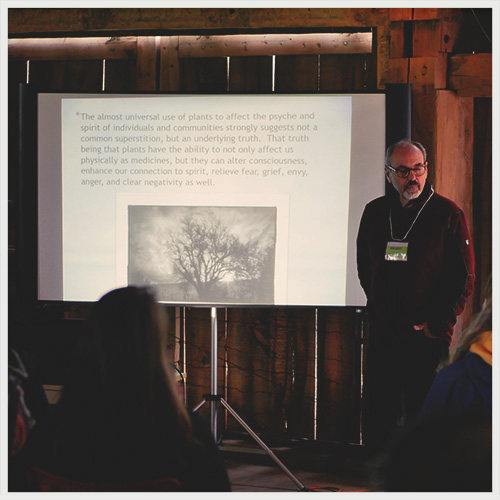
To conclude…
Everything Herbal: What is something heartfelt that you could share with new students or people who are just getting into herbal medicine? You speak of your love of herbs, but tell us about how this love shows itself.
David Winston: I don’t know if this is a direct response to your question, but I mentioned earlier that if I was born later I would have been diagnosed with both dyslexia and ADHD. I tend to get bored or distracted easily, unless a topic is deeply interesting to me and I can continue to learn about it. To me one of the blessings of herbal medicine, and this is true of medicine in general, is that as I said earlier I still only know a little bit of what there is to know. And I am just as enthusiastic and excited about herbs and herbal medicine today as when I first fell in love with plant medicines. The passion has not left me. When I am walking on a trail in the woods and I come across a plant that I’ve never actually seen before except in a photograph, it is just enthralling, it is like meeting my new best friend. It doesn’t have to be a showy plant. In the UK there is this plant called Pellitory of the wall or Pellitory on the wall. I have tried growing it here in the US and I’ve had limited success getting it to grow well and spread. It is used as a kidney trophorestorative, basically a food for the kidneys. I moved to my present home with my wife in 2014, and there is this plant I did not know growing on my property. I saw it multiple times and it wasn’t very showy, it’s green, you almost can’t see the flowers, and last year there was a great deal of it. I was going to go pull it up but then I thought to myself, I should look it up first. I discovered that it is called Pennsylvania Pellitory. It is in the same genus as the plant from the UK, but a different species. Immediately my reaction was ‘oh my goodness, it is growing right under my nose, and it really likes growing on rock walls just like the Pellitory of the wall in the UK!’ My questions then lead me to investigate, but I don’t have the answers yet. I found no ethnobotanical history of using this plant. Here is a relatively obscure plant with no history of use in the US, related to this English plant that I’ve wanted to use for years but haven’t had easy access to. So now I’m very excited and trying to find out any of the chemistry of the plant so I can compare it. I’ve tried tasting it (I do know it is not toxic!) to see if there is an organoleptic similarity, but unfortunately the English Pellitory is not very strong tasting or smelling. Now I am wondering if this can be used in a similar way to the other plant, and the answer at this point is that I have absolutely no idea. I don’t have access to phytochemical testing, so I have to see if there is any data or literature I can find, but the possibility of discovering an analog to an affective medicine makes me want to learn more.
People say if you learn something new it is a good day, and that is really true for me.
What can I learn today that I didn’t know yesterday, what new plant might I come across, what new use can I find for this herb or that herb, all of that to me is thrilling and I will continue with this work as long as I’m alive and mentally able. I have one of the largest private herbal research libraries in North America and I am constantly going back and looking at old books. I have books from the 1580s through to the present. I will take an old book off the shelf and be surprised by something I didn’t know, just as I can be surprised by some new research that comes out. The same can happen in class, when we are going over a case history and somebody says something that I didn’t know or think about before. It is just marvelous for me to be able to continue to learn. By continuing to learn, I am better able to share, better able to help others and hopefully in the process I contribute to making the world a better place for us all.
David Winston, RH (AHG) is an Herbalist and Ethnobotanist with 53 years of training in Chinese, Western/Eclectic and Southeastern herbal traditions. He has been in clinical practice for 46 years and is an herbal consultant to physicians, herbalists and researchers throughout the USA, Europe and Canada. David is the founder/director of the Herbal Therapeutics Research Library and the dean of David Winston’s Center for Herbal Studies, a two-year training program in clinical herbal medicine. He is an internationally known lecturer and frequently teaches at medical schools, professional symposia and herb conferences. He is the president of Herbalist & Alchemist, Inc. a manufacturer that produces herbal products that blend the art and science of the world’s great herbal traditions.
In addition, David is a founding/professional member of the American Herbalist Guild, and he is on the American Botanical Council and the American Herbal Pharmacopoeia Advisory Boards. He was a contributing author to American Herbalism, published in 1992 by Crossings Press, and the American Herbal Pharmacopoeia (AHP) , 2000-2018, the author of Saw Palmetto for Men & Women, Storey, 1999 and Herbal Therapeutics, Specific Indications For Herbs & Herbal Formulas, HTRL, 2014 (10th edition) and the co-author of Adaptogens: Herbs for Strength, Stamina and Stress Relief, Healing Arts Press, 2007 & 2019 2nd Ed, and Winston and Kuhn’s Herbal Therapy and Supplements; A Scientific and Traditional Approach, Wolters Kluwer/Lippincott, 2008. David has also published hundreds of articles in medical and botanical medicine journals and conference proceedings. He is also a member of the AHPA Expert Advisory Council that created the second edition of the Botanical Safety Handbook, CRC Press, published in 2013 (3rd edition in press).
In 2011 David was a recipient of the AHPA Herbal Insights award. In 2013 he received the Natural Products Association Clinicians award and was awarded a fellowship by the Irish Register of Herbalists. In 2018 he was the Mitchell visiting scholar at Bastyr University and in 2019 he was awarded an honorary DSc degree from the National University of Natural Medicine (NUNM) in Portland, OR.
You can find David online at davidwinston.org and his herbal training program available at herbalstudies.net
Photos provided by Serena Mor (excluding David’s first photograph)
Magic, Healing & Ritual: Herbal Tradition in the Italian Renaissance
Angels, Demons, Herbs and Magic
The ancient, and now largely lost and forgotten, tradition of illuminated herbal manuscripts can tell us much about the practice of herbal medicine throughout antiquity. It was not uncommon for such manuscripts to contain drawings of angels and demons, mythological figures and beings of the celestial hierarchies. Witchcraft and magic were taken to be very serious matters, not only when it came to cultural and religious belief systems, but also when considering the proper training of a physician. As one author writing on traditional Italian healing systems in antiquity has commented:
“Physicians were educated with the notion that drugs had occult powers to affect the body in special ways. It was common belief that demons invaded the soul, and that certain herbs had the property of chasing away devils and demons” (Silberman: 1996).
Expert Italian Renaissance physicians were required to be competent in astronomy and astrology “since the position of the celestial bodies contributed to the occult qualities of a medicinal herb” (Silberman: 1996). The Renaissance, as reflected in the writings of prominent philosophers of the time such as Giordano Bruno and Marsilio Ficino, saw a resurgence of pagan sensibilities. Renaissance thought and imagination embraced an animistic worldview that threatened the established, conservative branches of Christianity and their associated medieval superstitions. As the archetypal psychologist James Hillman writes:
“Renaissance animism led to pluralism, which threatened Christian universal harmony. For when inner soul and outer world reflect each other as enlivened souls and substances, and when the images of these souls and substances are pagan, then the familiar figures of Christianity diminish to only one relative set among many alternatives.”
This co-reflection or mirroring of the inner soul and the outer world are the life-stream of the ancient pagan and Renaissance herbal medical traditions of Italy and surrounding regions. This conception of a pluralistic world and of the enlivened human soul seen as a microcosmic reflection of the greater soul of nature helps us to understand the associations and correspondences that were made between particular herbs, supernatural, celestial, and divine beings, and the actions of the planetary bodies in the medicine of the time.
Medicina Antiqua Illustration depicting mandrake harvesting
Christianity and Paganism
In the Middle Ages there was much scorn for the Pagan worship of Goddess nature (who is synonymous with Venus or Aphrodite). This too is reflected in the medical manuscripts of the day. Consider, for example, the “editing” or erasure of an invocation to Gaia found in an early 13th century Viennese manuscript, Medicina Antiqua, by an unknown monk living sometime later in the Medieval period. The erasure in question was found on the back of an image depicting the invocation of the divine mother.
“She stands in classical clothing on the banks of a river in which the river god Neptune can be seen sitting with his trident on a snake. Mother Earth holds a cornucopia in her arms and is surrounded by stylized palms and fantasy plants.” (Müller-Ebeling: 2003, 184).
The fifty-one line invocation on the back of the image originally began “Sacred Goddess Earth, bringer of natural things…” but was changed to “To the Sacred God…” by the monk in question. In the 15th century, much of Northern Europe “fought hard for a reformation of the religious and moral foundations of spiritual life” but in sunny Renaissance Italy there was to be found an opening and renewal of the senses, a “rediscovery of classical sculptures of the gods as well as to texts that were bought from the cloisters by…Cosimo de’Medici” (Müller-Ebeling: 2003, 180).
Italian philosophers and artists of the time were concerned with understanding and exploring nature’s beauty and “the congenial side of the human character [was given much greater attention than was] the sinful” (ibid). A comparison of Germanic and Italian art of this period can be quite revealing; the former tradition is full of images of infernal hells (e.g. Hieronymus Bosch), the latter dedicated to an exploration of anatomy and perspective rooted in a renewed pagan grace (e.g. Leonardo, Raphael, Michelangelo). For confirmation of this claim, one can for example study the encoded pagan symbolism present in Michelangelo’s anatomical drawings.
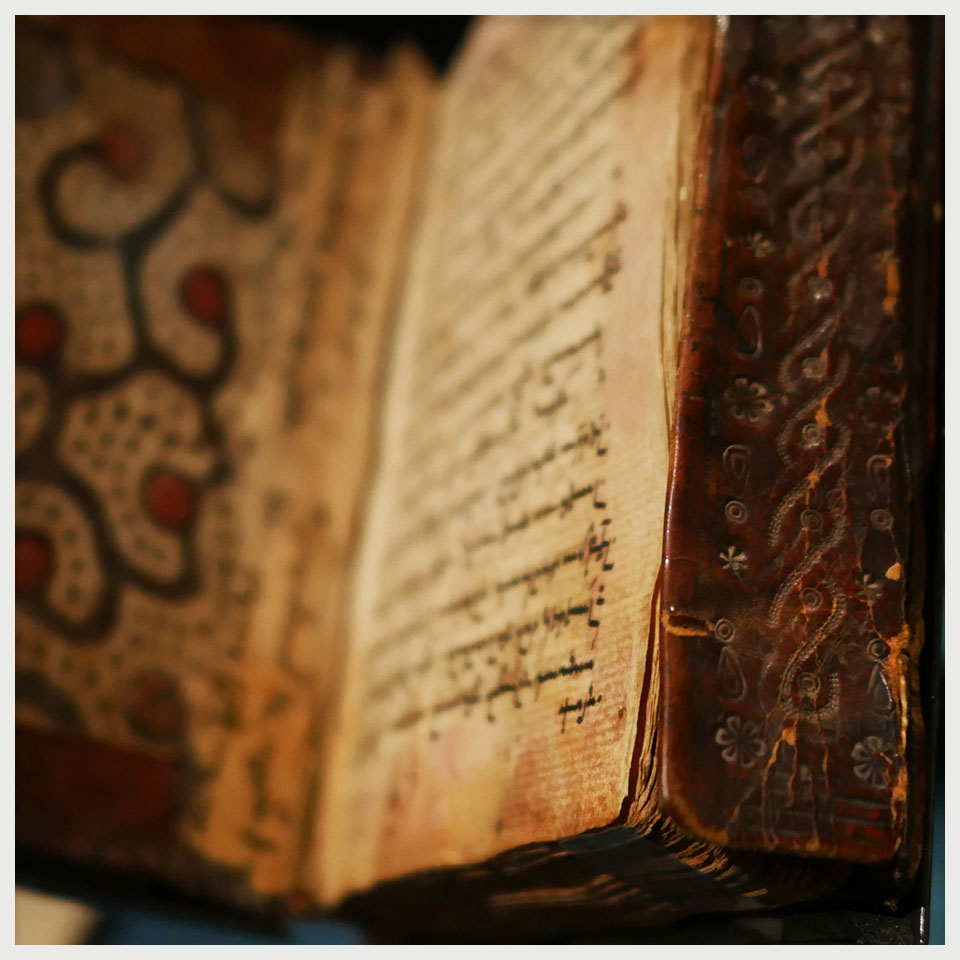
Pictured: 17th Century Bible
Given the church’s disdain for nature worship and resurgent pagan sensibilities, it is no wonder that Giordano Bruno, the Renaissance magi who considered medicine to be a branch of natural magic, was eventually burned at the stake for heresy (in particular, he was put to death for his belief in an infinite number of worlds). In his treatise De Magia Bruno provides a list of ten definitions of the words magic and magician. The one that especially interests us reads as follows: “Magician: someone who does wondrous things merely by manipulating active and passive powers, as occurs in chemistry, medicine and such fields; this is commonly called ‘natural magic’” (Bruno: 1998). For Bruno, the natural world and the divine world reflected and interpenetrated each other. To use and to understand herbs was to know, in the sense of gnosis, the action of divinity in nature; it was also to realize that through the work of learning to read the book of nature that one in turn serves to illuminate the divine:
“… for as the divinity descends in a certain manner inasmuch as it communicates itself to nature, so there is an ascent made to the divinity by nature, and so through the light which shines in natural things one mounts upward to the life which presides over them” (Bruno quoted in Yates: 1940, 183).
Bruno also gives us an insight into the common practice of using incantations and physical traces left behind by or belonging to a person to affect a cure or to set a curse in motion:
“Wicked or poisonous magic: incantations are associated with a person’s physical parts in any sense; garments, excrement, remnants, footprints and anything which is believed to have made some contact with the person. In that case, and if they are used to untie, fasten, or weaken, then this constitutes the type of magic called ‘wicked’, if it leads to evil. If it leads to good, it is to be counted among the medicines belonging to a certain method and type of medical practice. If it leads to final destruction and death, then it is called ‘poisonous magic’ (Bruno: 1998).”
Hellebore and Mandrake
Not all figures of the Italian renaissance shared the magical and animistic views of Bruno, and the more “rational” voices of the time thought that Bruno and his ilk were quite mad. But even among the more conservative authors, herbal medicine was still widely referenced and bound up with mythological associations. The famous poet Torquato Tasso took issue with Bruno’s worldview and in discussing his work quoted Erasmus’ phrase “Anticyram navigat”, literally ‘set sail for Anticyra’. Anticyra was a place that was known to contain an abundance of the herb hellebore (Veratrum album), then used as a cure for madness (Yates: 1940, 191)). Let us turn to consider this herb, and the related mandrake (Mandragora officinarum), both of which can serve to give us some insights into the practices and belief systems that existed in the Italian herbal tradition, especially the tradition maintained by the rhizotomes, or root diggers, the magician-herbalists of the ancient world.
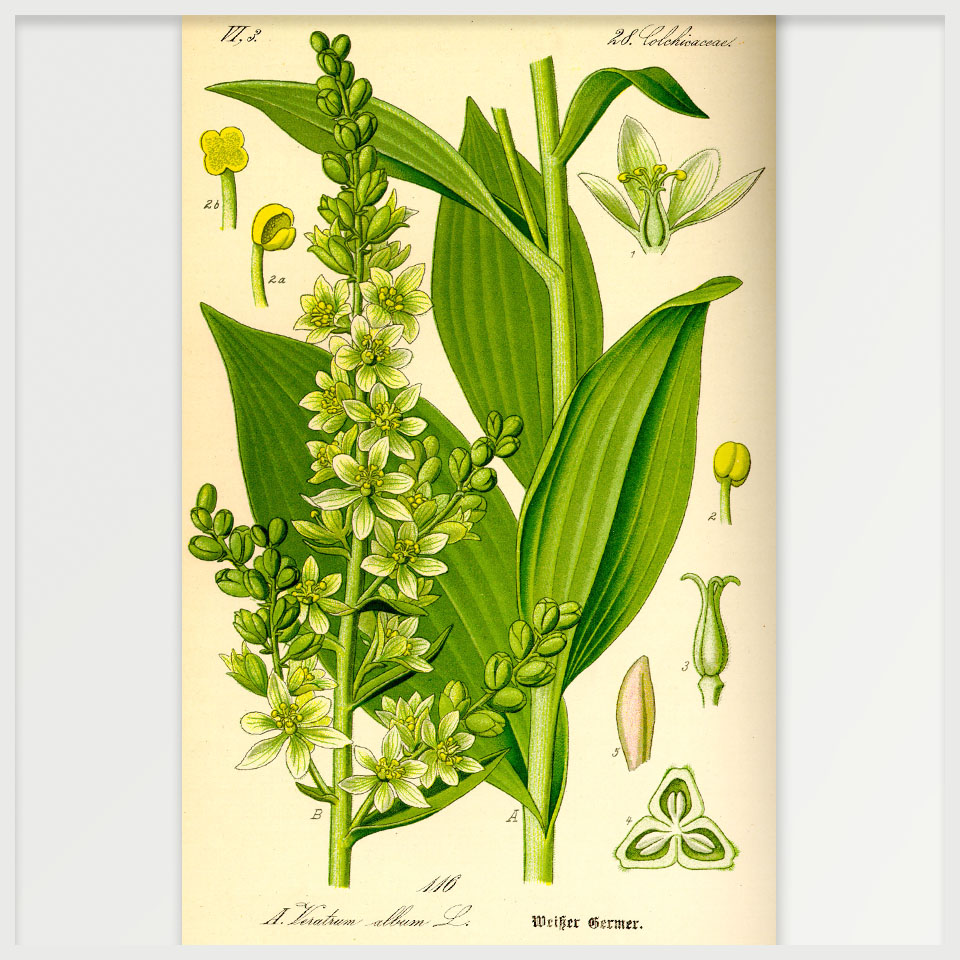
Hellebore (Veratrum album, white hellebore, veratro bianco in Italian); Helleborus niger, black hellebore) was a very important herb not only in ancient and renaissance Italy but also in Greece, France, and Egypt, among other places. Theophrastus maintained that the two types of hellebore were the most important medicinal plants that were used in ancient Greece and Rome. Contemporary ethnobotanist Christian Rätsch says of the hellebores: “they were the central medicines of the rhizotomes, diggers who nourished the magical plants with shamanic rituals. Hellebore was a sacred plant of the gods” (Rätsch: 2005, 525). Rätsch speculates that name helleboros is derived from hella-bora, which means “food of Helle.” The Hellespont is named after Helle who fell into this body of water after narrowly escaping death. Helle’s stepmother Ino resentfully roasted all of the seeds in the region of Boeotia so that a massive famine would result; this famine she blamed on Helle and her brother Phrixus, the stepchildren she so hated, in a ploy to have them killed. However, a flying golden ram sent by their birth mother Nephele saved these two. Helle fell from the ram into the Hellespont, where she was saved by Poseidon and metamorphosed into a goddess of the sea (in some less interesting accounts of the myth Helle simply drowned).
Rätsch argues that the most important documented use of this herb involved turning the root into a snuff. This is because “the artificially induced sneezing (the German name nieswurz means “sneezing root”) was believed to cause the demons of sickness to leave the body” (ibid). The Greeks and the Romans used the white hellebore1, which was ritually harvested in a way similar to the mandrake (Mandragora officinarum). Pliny gives a detailed account of the uses of white hellebore, which also gives us insight into the nature of medical treatment in the Rome of his time:
The body must be prepared beforehand for seven days by spiced food and abstention from wine, on the fourth and third day through vomiting, on the day preceding through fasting. White hellebore is also given in something sweet but is best in lentils or in a mush… The emptying begins after about four hours; the entire treatment is over in seven hours. In this manner, white hellebore heals epilepsy, …dizziness, melancholy, insanity, possession, white elephantiasis, leprosy, tetanus, tremors, foot gout, dropsy, incipient tympanic water, stomach weakness, charley horse, hip pains, four-day fever, if this will not disappear in any other way, persistent coughing, flatulence, and recurrent stomachaches (Pliny quoted in Rätsch: 2005, 527).
Consideration of the harvesting rituals common to hellebore and mandrake can give us interesting insights into the practices and beliefs of the rhizotomes as they engaged their art in Greek and Italian herbal traditions. The harvesting of these two plants involved many preliminaries and precautions. “Naturally a weird story of perils incurred in obtaining a plant strengthened belief in its magic powers and added to its commercial value” (Randolph, 489). Theophrastus describes the practices of the root diggers in his History of Plants, with specific reference to the mandrake: “Around the mandragora one must make three circles with a sword, and dig looking toward the west. Another person must dance about in a circle and pronounce a great many aphrodisiac formulas” (Theophrastus quoted in Randolph: 1905, 489). He also mentions the necessity of standing with one’s back to the wind so as not to be exposed to strong odours that some plants may emit, and anointing any skin not covered by clothing as a means of protection and defense. Other practices involved the “digging of certain plants only by night, [and] avoiding the sight of certain birds” (Randolph: 1905, 489). There were variations on these practices that depended on the plant being harvested and the uses for which it was intended. While the mandrake was to be dug up with one’s back facing west, hellebore was to be dug with one’s back facing east. Theophrastus notes that the practice of repeating aphrodisiac formulas as part of the harvesting of mandragora shows great similarities to the practice of repeating curses when sowing cumin seeds (Randolph: 1905, 490).
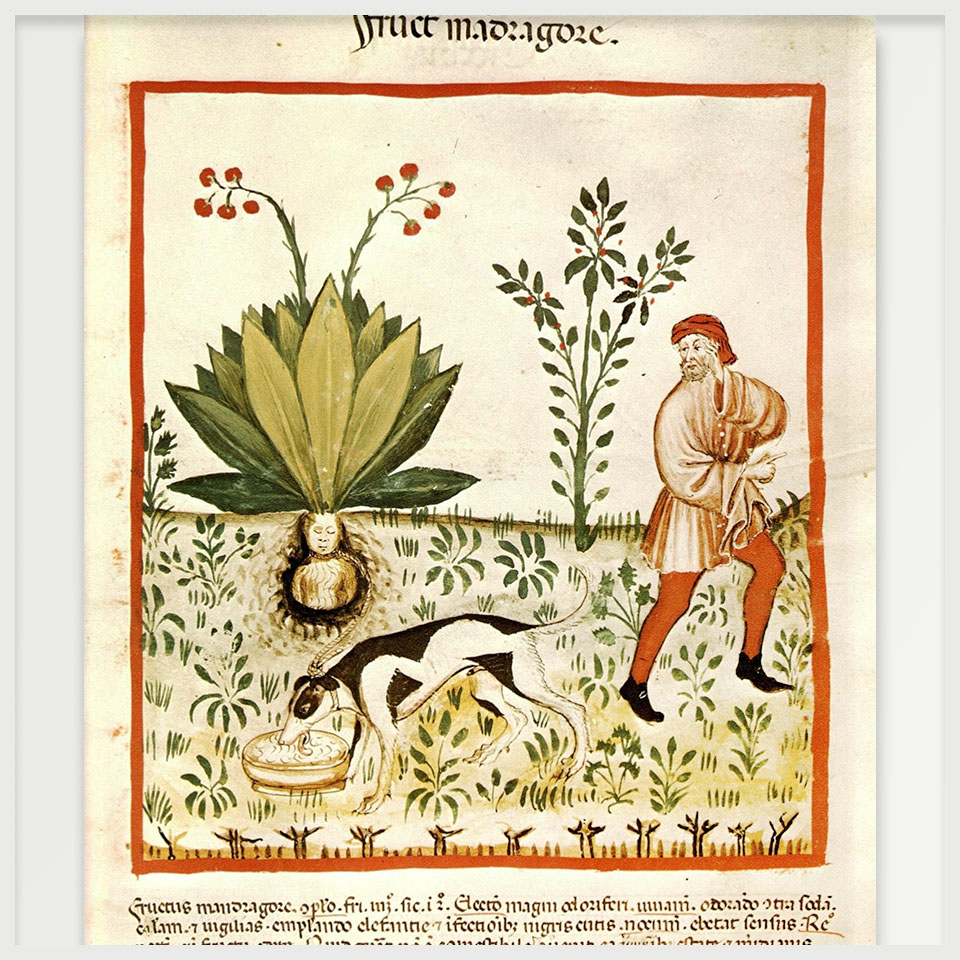
Mandrake Harvesting Illustrated in the Tacuinum Sanitatis manuscript, 1390
Pliny borrowed a great deal from Theophrastus and the account found in his Natural History of the practices of the root diggers and the harvesting of the mandrake in particular is one indication of this: “Those who are about to dig mandragora avoid a wind blowing in their faces; first they make three circles with a sword, and then dig looking toward the west” (Pliny quoted in Randolph: 1905, 490). We can notice however that Pliny says nothing of the “great many aphrodisiac formulas” that Theophrastus mentions in his account of the practices of the rhizotomes. Randolph suggests that “the omission by Pliny of any reference to aphrodisiac formulas is easily explained by his declaration that he will say nothing in his work about aphrodisiacs or magic spells except what may be necessary to refute belief in their efficacy” (Randolph: 1905, 490). This stance again speaks to the differences that existed in the ancient world between those who subscribed to the views and practices of natural magic and those who saw such a worldview as a breed of madness that must be rejected and defeated.
Aphrodisiacs were highly valued in Mediterranean herbal traditions, and one of the greatest of all of the aphrodisiacs was the mandrake. Rätsch comments that “in ancient times, the primary ritual significance of the mandrake was in erotic cults” (Rätsch: 2005, 348). However, only poor quality source material describing this usage remains and so detailed information about these practices is not available to us. Apart from its uses as an aphrodisiac, the mandrake was also widely used in medicine. Dioscorides:
A juice is prepared from the cortex of the bark by crushing this while fresh and pressing this; it must then be placed in the sun and stored in an earthen vessel after it has thickened. The juice of the apples is prepared in a similar manner, but this yields a less potent juice. The cortex of the root that is pulled off all the way around is put on a string and hung up to store. Some boil the roots with wine until only a third part remains, clarify this and then put it away, so that they may use a cup of this for sleeplessness and immoderate pain, and also to induce lack of sensation in those who need to be cut or burned themselves. The juice, drunk in a weight of two obols with honey mead, brings up the mucus and the black bile like hellebore; the consumption of more will take life away (Dioscorides quoted in Rätsch: 2005, 348).
The root diggers would only dig up the mandrake on the “day of Venus”, Venus of course being the Goddess of Love, which further suggests that one of the greatest virtues attributed to the mandrake in the ancient world was as an aphrodisiac, an agent in love magic/erotic rites (Randolph: 1905, 494). The mandrake is well known for its anthropomorphic appearance, and it is common in herbal traditions from around the world to attribute special healing powers to plants that resemble the human form (one can also think of the enormous sums that are paid in China even today for ginseng roots which look like human beings). Dioscorides and Pliny both make reference to a “male” and a “female” species of the mandrake but as Randolph clarifies “these terms, which the ancients applied to many plants, have nothing to do with sex, but signify more robust species (i.e., those having larger leaves, roots, etc., and attaining a greater height) and their opposites” (ibid).
The Goddess Circe
As we can see, herbal medicine in ancient and renaissance Italy, and throughout the Mediterranean region as a whole, was indissociably bound up with the workings of the gods and nature spirits. The Goddess Circe possessed a tremendous knowledge of herbs and, in particular, was regarded as a master of poisons (pharmaka). Her most famous plant was called Moly. To this plant were attributed psychoactive and aphrodisiac properties. Dioscorides referred to the mandrake as circeon, Mandragora Circaea being the herb that Circe used to transform Odysseus’ boat crew into “pigs.” (Müller-Ebeling et al. interpret this scene not in a literal sense but as an erotic transformation. The authors quote Apollonius: on the island of Circe “beasts, not resembling the beasts of the wild, nor yet like men in body, but with a medley of limbs went in a throng…such creatures, compacted of various limbs, did earth herself produce from the primeval slime…in such wise these monsters shapeless of form followed Circe” (Apollonius quoted in Müller-Ebeling: 2003, 117)). 19th and 20th century interpreters of the ancient literature (such as Dierbach and Kreuter) also take the Moly of Circe to be the mandrake. Theophrastus claimed that Circe lived in Lazio, a region in west-central Italy, where “the special medicinal herbs” were produced (Theophrastus quoted in Müller-Ebeling: 2003, 116). The sacred mountain of Circe, Monte Cicero, can still be visited today, on the Italian coast above Sicily. The early poet Aeschylus, according to Pliny, “declared that Italy abounds with potent herbs, and may have said the same of Circeii where she [i.e. Circe] lived. Strong confirmatory evidence exists even today in the fact that the Marsi, a tribe descended from Circe’s sons, are well-known snake-charmers” (Pliny quoted in Müller-Ebeling: 2003, 116).
Circe, goddess of death and guide of souls, was worshipped in groves. Apollonius notes that Circe’s groves, where executions were carried out, were lined with willows (Salix alba) and osiers/tamarisks (Tamarix spp.). Tamarisks and willows are well known medicinal trees. “The willow, or, more precisely, the white willow, was used for birth control; thus it was a typical witches’ plant” (Müller-Ebeling, 117). Two other plants sacred to Circe are the alder (most probably Alnus glutinosa) and juniper (Juniperus communis or Odorata cedrus, as it is recorded in Virgil’s Aeneid). Concerning the alder tree, it was said to surround Circe’s island (Aeaea or Eëa), located just south of Rome. Müller-Ebeling et al. comment:
“We can assume that there had been an archaic alder cult that by the Hellenic times had already been suppressed. Alders were considered transformed sisters of Phaeton, the son of Helios and brother of Circe” (Müller-Ebeling: 2003, 117). Juniper was Circe’s sacred incense and “therewith it is in the vicinity of archaic shamanism. Juniper is one of the oldest incense materials of the Eurasian shamans” (ibid).
Let us conclude our discussion of Circe by noting that though she has been described as compassionless and called the mother of darkness and horror, this noble sorceress was originally worshiped as a healing Goddess. As Giordano Bruno writes:
Ah, if only it pleased the sky, that for us today, like once long ago in happier centuries, this ever magical Circe would appear, who would be able to put an end to things with plants, minerals, poisons, and the magic of nature. I am certain, that despite her pride she was merciful with regards to our misery (Bruno: 1998).
Diana (Artemis) and Pan. Engraving after Annibale Carracci
What We Can Learn From This Symbiosis
To conclude, let us illustrate with another example just how bound up the practices of the healing arts were with the pagan pantheon of Gods and Goddesses – and consider how we can still learn from these sources of inspiration from the mythological imagination of the Renaissance. Consider Artemis/Diana, a woodland Goddess who served as the archetypal herbal healer throughout antiquity. She has very close ties to the animals of the forest, and oversees the wild hunt. Artemis is the goddess of the moon, the fierce protectress of the wild and of all of the life which courses through it, and it is she who governs the cycles of fertility and birth. Artemis’ garden is wild nature. Her role as a great shamanic healer is further brought to light through her representation as the “great she-bear, Ursa major, ruler of the stars and protector of the axis mundi (pole of the world) marked by the pole star at the centre of the constellation of Ursa Major” (Brooke: 1992). Artemis is closely associated with the artemisia plants, such as mugwort and wormwood (plants that help to enhance the clarity of consciousness, promote emotional resilience, and foster a refined sensitivity to and deepened awareness of our place in the world and our interactions with human and other-than-human nature). As explained in the Medicina Antiqua:
“There are three types of Artemisia. All three and their healing effects were discovered by the Goddess Diana. She transmitted this medicine chest to the centaur Chiron, who was the first to transform it into medicine. This is why these plants carry the name of Diana, or rather Artemisia” (Medicina Antiqua 13, fol. 32r).
When we read this and related sentiments, it becomes clear that without Artemis the tradition and practices of the Renaissance magi-herbalists would be inconceivable.
Healing was, in the Renaissance traditions here under discussions, associated with the qualities of grace and beauty. Artemis/Diana was said to be exceptionally beautiful, her beauty being comparable even to that of Aphrodite. Psychologist Ginette Paris suggests that Artemis sanctifies “solitude, natural and primitive living to which we may all return whenever we find it necessary to belong only to ourselves” (Paris: 1986, 124). In her capacity as a huntress and archer, she can bestow upon us the wild, atavistic power that can be utilized to resist the forces of domestication and domination. Artemis is the great protectress of flora and fauna, and thus she has a special bearing on the ecological issues that face living beings on the Earth today. It would be wise to look to her when making choices that will affect the future of the natural world.
“There are obviously many ways of entering into therapeutic contact with nature, but solitude and identification with nature through falling water, trees, or animals are cues that our contact is with Artemis rather than Dionysus, Demeter, or Aphrodite” (ibid, 127). The waters of the mountains and streams are also under the care of Diana, and if we are to re-enliven our sacred relationship to this elemental force then “perhaps, afterward, the nymphs, naiads, and nereids would return to inhabit our imagination and teach us the necessary respect for the waters of Artemis” (ibid). Let us not forget the mythological traditions of healing and the great bearing they can have on contemporary consciousness, let us take heed not to neglect the great Pagan wisdom of the wild imagination.
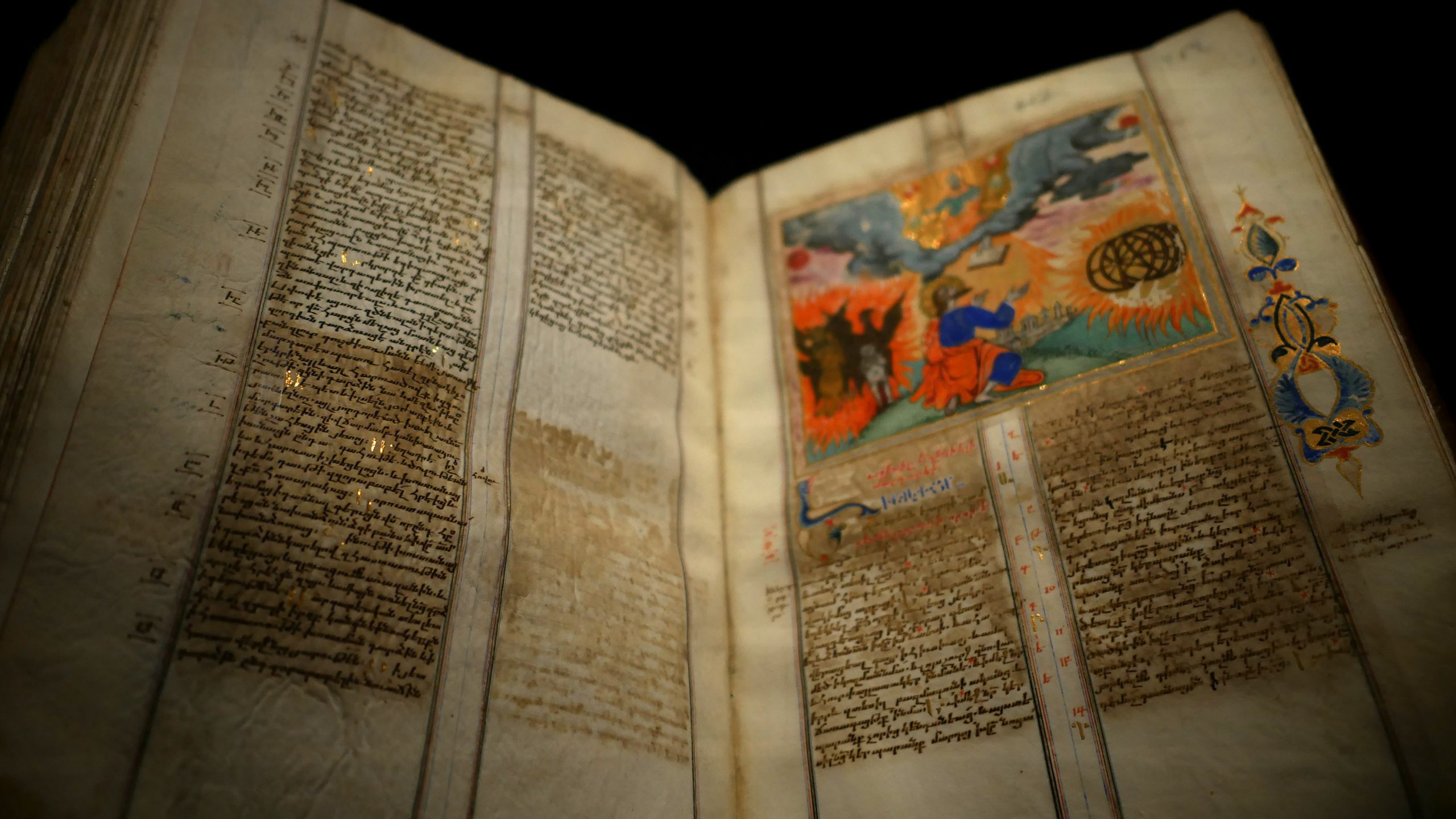
Bible page depicting the prophet Ezekiel’s Vision, 1648
Footnotes:
1 Daniel Schulke claims that black hellebore is “a poison of decided infamy; all parts of the plant render up potent venoms” (Schulke: 2017, 132). An extract of the rhizome was used in antiquity and into the medieval era as a “utensil of murder, most notably by King Attalus III of Pergamos” (ibid). Black hellebore contains the glycosides heleborin and hellebrin, which are chemically related to telo-cinobufagin (venom found in some species of toad skin). These glycosides slow the heart rate and affect cardiac muscle in a similar way to foxglove. The Key of Solomon the King contains a recipe for an incense to be used as part of a “spell for vivifying a talisman with the genius of Saturn” containing the stalks of black hellebore along with alum, assafoetida, scammony, sulphur, and cyprus ash (ibid).
Works Cited:
- Brooke, Elisabeth. A Woman’s Book of Herbs. London: Aeon Books, 1992.
- Bruno, Giordano. Cause, Principle and Unity: And Essays on Magic. Cambridge: Cambridge University Press, 1998.
- Hillman, James. Re-Visioning Psychology. New York: Harper, 1976.
- Müller-Ebeling, Claudia, Rätsch, Christian, and Storl, Wolf. Witchcraft Medicine: Healing Arts, Shamanic Practices, and Forbidden Plants. Vermont: Inner Traditions, 2003.
- Paris, Ginette. Pagan Meditations. Connecticut: Spring Publications, 1986.
- Randolph, Charles Brewster. ‘The Mandragora of the Ancients in Folk-Lore and Medicine.’ Proceedings of the American Academy of Arts and Sciences, Vol. 40, No. 12 (Jan., 1905), pp. 487-537.
- Rätsch, Christian. The Encyclopedia of Psychoactive Plants. Maine: Park Street Press, 2005.
- Schulke, Daniel. Veneficium: Magic, Witchcraft, and the Poison Path. San Francisco: Three Hands Press, 2017.
- Silberman, Henri. ‘Superstition and Medical Knowledge in an Italian Herbal.’ Pharmacy in History, Vol. 38, No. 2 (1996), pp. 87-94
- Yates, Frances. ‘The Religious Policy of Giordano Bruno.’ Journal of the Warburg and Courtauld Institutes, Vol. 3, No. 3/4 (Apr. – Jul., 1940), pp. 181-207.
Illustrations/Images:
- Medicina Antiqua Illustration
- 17th Century Bible: (photo provided by Serena Mor)
- Veratrum album Illustration
- Mandrake Harvesting
- Diana (Artemis) and Pan
- Prophet Ezekiel’s Vision: (photo provided by Serena Mor)
Cannabis: Medicine or Poison?
An Exploration from the Perspectives of Traditional Systems of Healing
With the legalization of cannabis in Canada, we are seeing a growing public acceptance of this herb, an enormously expanding “cannabis industry”, and a variety of claims being made about its medical efficacy and utility. There are many well-documented traditional medical uses of cannabis, going back many hundreds of years, along with a growing body of contemporary scientific evidence supporting its various medicinal virtues. Yet many of the contemporary claims made about cannabis – branded as a miracle drug – are driven by the desire to sell products or simply as means of justifying one’s indulgences and addictions. In what follows, we will explore cannabis from the perspective of traditional systems of healing and consider some of the less acknowledged and discussed adverse reactions and disturbances that result particularly from its chronic use.
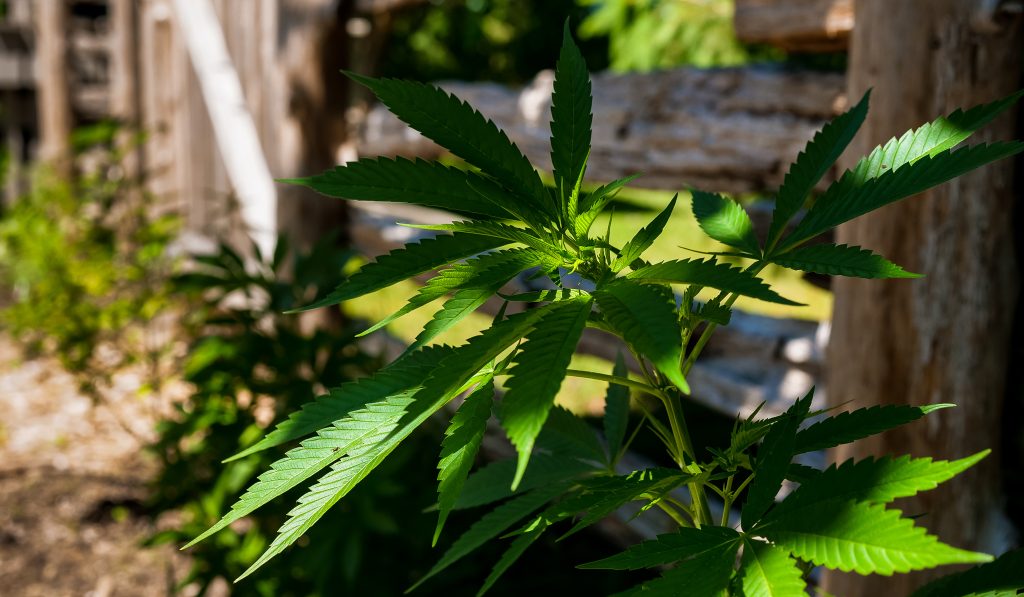
Sola dosis facit venenum; “All things are poison, and nothing is without poison; the dosage alone makes it so a thing is not a poison.” All medical practitioners, irrespective of their methodology or tradition, should carefully consider this phrase, attributed to the alchemist Paracelsus (1493 – 1541). In our era of one-size fits all medicine, Paracelsus’ insight into the difference between a medicinal and poisonous action of a substance being in the dose is not so widely understood. It is however quite germane to our discussion of cannabis, and rife with implications for understanding the nature of the substance. Paracelsus’ dictum leads us to the primary realization that the benefits or dangers of any substance – be it a food, herbal supplement, pharmaceutical drug, etc. – are entirely dependent upon the level and degree of an individual’s susceptibility to that substance. This phrase also asks us to question the range of effects that a particular substance can have, leading us to explore the nature and definition of a poison effect. Poisoning is not equivalent to a lethal dose, though it can lead there. Poisoning, we can say, is when an individual’s capacity for feeling and function has been disturbed.
Every Day Use
It is with chronic, daily cannabis use that we can often observe a very clear disturbance of an individual’s capacity for feeling and function, though the user may not always be able to perceive such an alteration. Many cannabis users have become convinced that their daily habit is what allows them to function, to be more creative, more emotionally balanced, more spiritual, less anxious, better able to relax and to sleep, etc. More often than not, those who make these emphatic claims have fallen under the spell of cannabis, and are no longer able to see beyond its alluring veil.1 As homeopath Colin Griffith explains: “what these users fail to see is that whatever effects their bodies manifest do not belong to them but to the drug. They are instruments on which the chemical drug is playing tunes. The effects are no more theirs than they would be if they took antibiotics for a tooth abscess.”2
In response to a patient’s inability to live her life without the use of cannabis, the natural medicine practitioner should ask: why is it that you are not able to function optimally in the first place? What are the underlying maintaining causes of your emotional imbalances and disturbances? Why do you have such difficulty relaxing and falling asleep? In such cases cannabis use may only be serving to suppress or cover over an underlying constitutional issue that needs to be properly addressed. And when we suppress a problem, rather than working to resolve or cure it, this may result in its temporary disappearance, but it certainly has not gone away. Suppression takes a surface manifestation of a disease and drives it to a deeper, more vital region of the organism, where it can create more chronic, intractable and debilitating illness.
An Ancient Medicine
Cannabis has a long history of use as a medicine. The Persian physician Avicenna (980 – 1037), who no doubt was familiar with cannabis strains much different than those that are available today, wrote of the use of cannabis for the alleviation of severe headache as well as treatment for degenerative bone and joint diseases, inflammation of the eyes, general edema, infectious wounds, gout, and uterine pain. However, he also pointed out that cannabis produces dryness that is “desiccating” (disrupting and deranging the vital fluids/fluid metabolism of the body). There are many clear signs that cannabis is warming, including increased appetite, red eyes, dry mouth and tongue, rapid heart rate and elevated blood pressure. As cannabis is excessively warming, it can result in a disturbance of the warmth activity of the organism, especially with regards to the metabolism. Chilly, sluggish and deficient digestive processes can often be observed in chronic cannabis users. The above mentioned symptoms are especially pronounced when it comes to the intensely psychoactive strains of cannabis that are grown today.
From the perspective of Traditional Chinese Medicine, it can be said that chronic use of cannabis can result in injuries to the Yin, damage to the Jing, and disturbance of the Shen. The primary constituent that causes such disturbances is THC. This is because, as herbalist Paul Bergner has remarked, “THC binds to the encocannabinoid receptors (CBD does not), and because it is many times more powerful than the endocannibinoids, the receptors drop in number and also become less responsive to maintain homeostasis.”3 Daily cannabis consumption often leads to gradually increasing dosage and frequency of use, clearly suggesting that tolerance and adaptation can develop quickly and easily.
Herbalist Todd Caldecott provides us with a useful explanation of cannabis from the perspective of the Ayurvedic tradition:
“Cannabis displays some of the properties of a poison, in that it spreads very quickly (vyavahi) and loosens (vikashi) the tissues. Through its subtle (sukhma) and penetrating (tikshna) qualities, it actually expands the space between all the cells of the body, opening up the channels (srotamasi). This is the reason for feeling high, and why it is consumed by sadhus and babas [who, unlike the average person, have been trained to focus their mind through contemplative practices]. It creates a subtle feeling experience that connects our experience to akasha (ether), the element of pervasiveness. So it opens and elevates consciousness, but not in an evolutionary way – just as a transient and limited experience of infinite space.”4
It is because cannabis serves to create space and allows for movement in the body that it can exhibit pain-relieving properties. It is for the same reason that cannabis can be utilized in some cancer treatment protocols (cancer is an uncontrolled proliferation of cells, when the tissue of our body can no longer maintain or identify its own boundaries. Hence, cancer is a disease that is very much related to ‘space’).
Recreational Use
While the chronic use of cannabis presents more pronounced dangers than occasional use does, infrequent or recreational consumption can still cause deep-seated disturbances on the level of body, mind and spirit – again, if that degree of individual susceptibility is there in a person. The use of cannabis “to relax”, for example, can easily become an addiction in the same way that others become addicted to drugs like diazepam to go to sleep at night or to “manage” (suppress) their anxiety symptoms. Such addiction is an often unconsciously motivated attempt to circumvent having to develop strategies and lifestyle changes that can lead to true understanding of the root causes of one’s issues. Without such an understanding, true resolution or cure is not possible.
The Physical Effects
Cannabis regularly results in a disturbance of the bladder, prostate, and sexual functioning in men. Cannabis can act as a potent aphrodisiac in the short term, but will usually lead to a lessening of erotic desire and even to impotence in some. Habitual use of cannabis results in a lowered white blood cell count, suggesting its negative affects on immune function. The homeopathic materia medica and provings of cannabis reveal that the adverse immune response that cannabis precipitates increases an individual’s susceptibility to bacterial respiratory infections as well as non-specific urethral infections, gonorrhoea, and chlamydia (homeopathic cannabis is an especially well known remedy in the treatment of gonorrhoea, and is indicated for genital discharges with burning pains and discomfort more generally).
The homeopathic materia medica of cannabis also reveals a strong affinity for disturbances of the thinking processes, with pronounced disorientation and a sense of disconnection accompanied by a free floating anxiety. The patient requiring homeopathic cannabis may often make mistakes in reading and writing and may generally have poor comprehension, tend to be forgetful and can become easily confused. While there can be difficulty concentrating, there can also be rapid thoughts and a pronounced tendency to theorize and draw far-fetched connections. Patients requiring homoeopathically potentized cannabis may report a sensation of the head being separated from the rest of the body (a symptom that says much about the state of being too much in one’s head, which cannabis in its crude form easily leads to. When this state progresses to severe pathology we can see, for example, paranoia and depersonalization. While cannabis users may give the appearance of being mellow and laid back, this appearance is often a symptom, as Colin Griffith notes, “of the distance that the cannabis has fostered between the smoker and reality”5). Other notable cannabis symptoms from the homeopathic literature include: sensations of being ungrounded, spaced out, unable to physically support oneself, of the limbs or the whole body feeling so light that it could float away; panic attacks, many fears including the fear of being alone in the dark, of entities, and of insanity. Rajan Sankaran notes that cannabis patients tend to exhibit oversensitivity and the need to “cover up for a feeling of inadequacy…The perceived weakness is actually an inadequacy in facing the threats, dangers and risks of the outside world. The Cannabis person feels unequipped to face them directly and hence observes the world from within the safe confines of a “glass cage.””6
Many of the above mentioned symptoms of chronic cannabis use are further understood when we consider the effects that cannabis has on our neurology. With prolonged use, cannabis disrupts the balance between the thalamus and hypothalamus and the pineal and pituitary glands. The anterior pituitary gland is responsible for the secretion of thyroid stimulating hormone, adrenocorticotrophic hormone, growth hormone, follicle stimulating hormone, luteinising hormone, and prolactin. We have a growing body of evidence suggesting that cannabis use results in significantly lowered levels of thyroid stimulating hormone. The hormones released by the thalamus and hypothalamus serve to regulate our flight and fight response, our appetite, thirst, and eliminatory processes. Negative modifications to these bodily functions are typically present after long-term use – at which point cannabis addiction tends to have already set in.
Ongoing pharmacological research on THC strongly suggests that it has marked affects on neuronal signaling and development, and researchers are beginning to explore how THC exposures during pregnancy could lead to adverse long-term changes in the neuronal development of babies and infants.7 Other research has drawn links between mother’s who smoke cannabis during pregnancy and an increase in the risk of their children developing leukemia and a variety of other serious birth defects. There have been further studies suggesting an increased risk of cancer of the esophagus and stomach with chronic cannabis use.
In Conclusion…
Cannabis is a complex herb, and one that should be carefully understood by those who use it. While public perception presents us with a marketable (and hugely profitable) image of cannabis, the reality of cannabis is more nuanced, multifaceted and complex than we are led to believe.
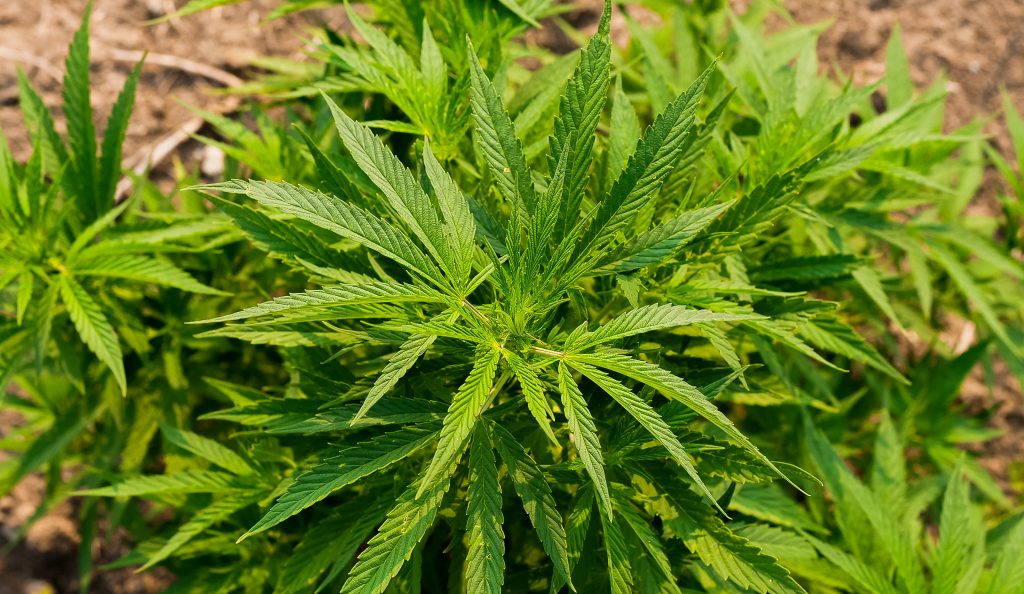
Footnotes:
1 From the perspective of the doctrine of signatures, the usually 5-leaved cannabis plant closely resembles a hand. This hand, it can be said, reaches for and makes an effort to grab hold of the cannabis user, who is rendered incapable of extricating herself from cannabis’ intoxicating embrace.
2 Colin Griffith, ‘The Companion to Homeopathy’ pg. 169.
3 Paul Bergner, unpublished writing.
4 Todd Caldecott, unpublished writing.
5 Griffith, ibid, pg. 168.
6 Rajan Sankaran, ‘The Soul of Remedies’, pg. 39.
7 See, for example, Kimberly S. Grant et al. ‘Cannabis Use during Pregnancy: Pharmacokinetics and Effects on Child Development.’
Photos provided by Serena Mor
From Biophilia to Biophobia
The Love and Distrust of Herbal Medicine
The process of modernization can be described as the transformation of biophilia (the love of and communion with nature) into biophobia (the fear and distrust of nature). Industrialization and the commoditization of everyday life are only some of the more recent forces that cemented this change, which in reality reaches much further back into Ancient Greece and Rome, as can be see in the hegemonic Christianization of Pagan culture, or the decline of Greco-Roman polytheism.
The transformation from biophilia into biophobia should be of interest and concern for herbalists and practitioners of natural medicine generally, as it is the underpinning of the ideological foundation of the ideas that many today harbor towards non-pharmaceutical based healing traditions and practices. These contemporary attitudes which espouse, for example, the notion that plant based healing is dangerous, untrustworthy, ineffective, unscientific, etc., are part of a much larger fear of the wild that stems from a generations long process of alienation from nature. Herbalist and ethnobotanist Wolf-Dieter Storl discusses how the forest, once held to be a magical and paradisiacal realm of great mystery and grace, gradually became a place of fear and trepidation. Wild plants that once provided sustenance in the form of food and medicine to one’s ancestors came to be regarded as potential poisons that should not even be touched, let alone ingested. This distrust and abhorrence of nature is the essence of biophobia. Biophobia is a treacherous trap for the body, mind, soul and spirit that has been laid down alongside and in lock step with the deployment of the global machinery of industrial society and the shifts in human perception and spiritual life that lead to it.
Speaking to the legacy of biophobia in the Western world, Dieter Storl writes:
“Western people are scared of rabid foxes, and they are afraid to eat wild raspberries or blueberries – after all, they might be contaminated with fox tapeworm eggs. And there are ticks, which can cause Lyme disease and encephalitis if they bite you. The best solution is never to go into the forest! (Or you can do what many do when they go hiking, and march through the forest as if through enemy territory). When considered soberly, however, the fear of the forest reveals itself to be mere hysteria. The likelihood of catching rabies or tapeworm in the woods is less than the chance of being hit by a truck. The fear of the forest is the fear of one’s own soul, of the “evil witch,” of the shadows of one’s own personality.1”
The fear of the soul is often tied up with the repression of bodily feeling and somatization (any unconscious and nonvolitional process where physical symptoms are produced as a consequence of one’s ill-founded psycho-emotional attitudes and disposition). It is through the soul that we are capable of producing bonds of intimacy between self and world. The last century in particular has seen massive increases in the technical proficiency of machine technologies, but this has come at the cost of understanding the importance of nurturing the capacity to sense, feel into, and thereby be transformed by the natural world. When this capacity is diminished or lost, nature then becomes something that exists outside the boundaries of the self, something that indeed is thought to threaten the stable foundation and identity of the self. The felt sense of immediate experience, the communion with other-than-human life, is substituted for an abstract realm of thought governed by the separation and division of subject and object, self and other, inner experience and outer nature… When the awareness of “external” nature is repressed, then so too is our own bodily awareness.
Of Repression
There are few places where the legacy of this repression is reflected more strongly than in the transformation of agricultural work and attitudes towards the land. The great Goddess guided early farmers and agriculturalists through her gifts of vision, inspiration and dreams.2 It was understood by our ancestors not only that the Goddess stands as our protectress, but also that she sees, hears, feels, and mourns, that she is part and parcel of every aspect of our experience as living, breathing beings on planet Earth. The benevolence of the Goddess is what makes the soil fertile, and her guidance is what allowed agricultural societies to emerge and prosper. As Dieter Storl continues:
“Agriculture progressed in a continuous dialogue with her [Goddess Nature]. Plowing and tilling the soil were considered an act of love; impregnating Mother Earth was the religion, and those who impregnated her were the worshippers. In fact, the word cultivate originally meant nothing more than service to the gods, honor, sacrifice, and nurturing.”3
A far cry from the Round Up drenched, monocropped fields of contemporary agricultural production.
Of Forgetting
The forgetting of the benevolence of the Goddess should be thought of in relation to the demonization of the Pagan Gods, Ancient Greece and Rome more generally. This was a development that, as noted above, was ushered into being through the proliferation and enforcement of domineering strains of Christianity. We can see this quite clearly in the gradually shifting attitudes and attributes bestowed upon Greek and Roman tutelary deities (i.e. guardian, patron, and protector spirits). Faunus, to take but one example, was the ancient Roman God of the forest, plains and fields, the guide and protector of shepherds, huntsmen and all inhabitants of the countryside. He was a great companion of the nymphs, the feminine nature deities who populated and cared for the myriad creatures of the Earth and presided over the diverse phenomena of nature, from springs and waterfalls to clouds, trees, caverns and meadows. Faunus played a great role in the fertility cults of the ancients, and was honored as an important overseer of both agricultural production and the health of the forest, as well as (in his form or aspect as the God Innus) the primal embodiment of human sexuality and procreative powers.
Faunus was depicted as a voluptuous and sensual being and, in some traditions where he was held to be synonymous with the Greek God Pan, as the inventor of the flute, whose music charmed wild animals and appeased the spirits of nature. Faunus was one of the favourite and most honored Gods of the Romans, as Pan was for the Greeks. Innumerable shrines and monuments in honour of Faunus/Pan were placed throughout the countryside and in wild places. And it was perhaps for this very reason, that of the immense popularity of Faunus and of Pan, that Christian theologians felt it incumbent upon themselves to cast these most beloved of Gods into disrepute, striking fear in the hearts of their worshipers and devotes with the threat of the eternal damnation of the soul.4
Of Demons and Angels
In the Greek translation of the Old Testament, the Septuagint, ‘good’ spirits are described as angels (ángelos, ἄγγελος “messenger”) and ‘evil’ spirits as demons (daimónia, δαιμόνια). This dichotomy of good and evil was foreign to the Greek notion of a daimon, which simply meant “godlike”, “power” or “fate”. Daimons were originally held to be benevolent and benign deities who oversaw the rightful and just fulfillment of fate and destiny, not as less than divine or malicious spirits who corrupted human nature and condemned souls to hell.
Faunus and Pan thus became nightmare demons. Where they were once the bestower of prophetic dreams, they became the harbinger of fearful illusions and malefic hallucinations. Where they once stood as one of the principal life-givers and protectors of the forest, they became the embodiment of the ‘dark’ side of nature, of that which needed to be kept at bay. The Greeks came to see those who suffered from epilepsy, for example, as being possessed by Pan (for the Greeks and Romans alike, epilepsy and madness were very closely related; epilepsy was thought to be the precursor to madness).5 The Romans ascribed a series of afflictions to an incubus by the name of Faunus ficarius, including “emaciation, violent unrest at night, and agonizing pains.”6
Of Written Word
Textual tradition, and the power and authority that came with it, also played a great role in the transformation of medicine from an ancestral, folk tradition of healing to something that was overseen and governed by the men of letters (the state licensed Doctors). In his book The Social Transformation of American Medicine, Paul Starr describes the folk healing traditions of the early American settlers, that the Doctors were later to chastise and condemn, in the following way:
“The family, as the center of social and economic life in early American society, was the natural locus of most care of the sick. Women were expected to deal with illness in the home and to keep a stock of remedies on hand; in the fall, they put away medicinal herbs as they stored preserves. Care of the sick was part of the domestic economy for which the wife assumed responsibility. She would call on networks of kin and community for advice and assistance when illness struck, in worrisome cases perhaps bringing in an older woman who had a reputation for skill with the sick.7“
Many of these women, who carried out the traditions of their ancestors in supporting and upholding the life and health of their communities, were to be persecuted as witches. The folk medicine that they worked to maintain came to be held up as heresy.
The state licensed doctors were as ignorant of the virtues of traditional healing systems as were the Inquisitor’s of the marvelous virtues of the Pagan gods that they sought to demonize. The doctors were able to remove the popular healers with great urgency by falsely casting them as witches who perpetuated evil and misfortune, just as the Inquisitors were able to divorce the Pagans from their animistic immersion in the world through the introduction of the dichotomy of good and evil and the threat of eternal damnation.8
Of Understanding
To understand the state of traditional medicine and the folk healing arts today, and why such traditions have been cast in such a negative light, it is important to understand the conquest of nature that began far back in the ancient world. Such conquest served to gradually divorce humankind from the experience of the living world in its pure immediacy. But the repressed always returns, and the living memory of health and harmony is again today finding its rightful place in the hearts of many.
Footnotes:
1 Wolf-Dieter Storl. Witchcraft Medicine. Vermont: Inner Traditions, 2003. Pg. 2-3.
2 When one looks, for example, to one of the earliest known sculptural representations of the face, the approximately 25,000 year old figure of The Venus of Brassempouy, it becomes abundantly clear how deeply rooted in the ancient past is the worship and devotion to the Goddess as the bestower and protector of life.
3 Ibid, pg. 3.
4 Not all Christians, however, were opposed to Pagan ideals. There was in fact a tradition of associating Faunus/Pan with Christ himself. Both Faunus/Pan and Christ were shepherds. Neither were entirely divine, Jesus Christ being simultaneously divine and human and Faunus/Pan was likewise a God as well as an earthly being, in part due to his very close and intimate association with humankind. Given this fusion of human/divine characteristics in both the figures of Faunus/Pan and Jesus Christ, some later Christian poets, including most notably John Milton, described Faunus/Pan as a pagan prefiguration of Jesus Christ. Such prefigurations were generated by poets who lived mostly after the Reformation period, and not by priests, bishops, or popes, or those were behind the bloody conquests and inquisitions of the ancient world.
5 Marten Stol. Epilepsy in Babylonia. Groningen: STYX Publications, 1993. Pg. 49.
6 Wilhelm Heinrich Roscher. Pan and the Nightmare. New York: Spring Publications, 1990. Pg. 65.
7 Paul Starr. The Social Transformation of American Medicine. New York: Basic Books, 1982. Pg. 32.
8 For more on this, one can consult the work of the the American anarchist historian and activist Fredy Perlman, who describes the conquest of the doctors in the following vivid language: “The so-called witches, heiresses to the informally transmitted knowledge of herbs and illnesses, are known to be healers, whereas the Doctors, notoriously ignorant of all this lore, are intent on establishing a State-licensed monopoly over illness so as to police the sick. The Doctors will eventually appropriate some of the herbal knowledge of the exterminated witches, but the healing will always be incidental to the policing. They will persecute illnesses even if they have to turn human beings to vegetables or cut them to shreds… Leviathan’s licensed agents even move to expropriate radical visionaries of their memory of human freedom, kinship and community. State-licensed visionaries, Masters and Doctors of Letters, Philosophy and Metaphysics, send their tentacles probing among the last traces of memory’s remembered humanity. The lettered Doctors appropriate the witches’ healing arts.” Fredy Perlman. Against His-Story, Against Leviathan!. Detroit: Black and Red, 1983. Pg. 238.
Photos by Serena Mor
Healing The Rift
The Healing Professions, Human Freedom and The Social Good: Book Burning and the Psychic Depravity of Authoritarianism
From their heights the Gods reach down into the ocean of humanity and feel the warmth of love. We know that the Gods lack something when man does not live in love. The more human love there is on earth the more food for the Gods there is in heaven; the less love there is, the more the Gods hunger. - (Rudolf Steiner – GA 105 – Universe, Earth and Man: IX – Stuttgart, 13th August 1908)
Those who are genuinely engaged in the healing professions have an absolute and unshakeable responsibility to perpetuate and promote health, harmony, love, truth, and justice in the world. Medicine is to be practiced in the service of The Good. The primary task of a healing professional is to work for the benefit of humankind, to promote the flourishing of life, to alleviate suffering to whatever extent they possibly can, and to allow for individuals and communities to reach their highest potentials in body, mind, soul, and spirit. It is incumbent upon healers to cultivate the courage to heal in themselves and in their patients, for it is no small responsibility to help the sick and requires nothing less than unwavering and unfaltering devotion.
It is untoward for healers to perpetuate lies, illusions, and false-truths. Lies and illusions affect human beings in very deep ways, and are in fact the underlying cause of a great many illnesses and states of dis-ease. Our soul life becomes greatly compromised when we are fed unlawful images or repeatedly exposed to deceptive and manipulative words. Such impressions that are marked with the insignia of their own falsity and untruth create unconscious disharmonic resonance patterns that affect the entire organism in very adverse ways. Unlawful images direct the soul away from what is good, beautiful and true in nature, and this inevitably leads to states of malaise, characterized by mental instability and tendencies to violence. The healing of the soul and the healing of nature both require that we pay attention to the flow of inner images, and learn to be guided by true Imagination, which is integral to our capacity for genuine love and devotion.
True Imagination is also what allows us to feel into the inner experience of another, to demonstrate empathy. Rudolf Steiner taught that empathy is a prerequisite for true healing. Healing must start with empathy, for it is empathy that allows one to generate an understanding of and feeling for another person’s underlying circumstances and condition. It is empathy that teaches and allows us to metabolize another’s experience, and to recognize what it is that needs to be healed in them.
The Controversy
Recently, a massive controversy has erupted in the international online herbal medicine community. An article written by Stephen Harrod Buhner entitled ‘The Day The Woke Mob Came for the Herbalist’ is what sparked this controversy. This article is available here for anyone who cares to read it.
Many people took issue with Buhner’s article for a variety of different reasons, and many adamantly supported and promoted his views. It is not my prerogative here to explore what Buhner is or is not saying in this piece. Both sides of the divide have ended up accusing each other of misunderstandings, exaggerated and false opinions, distortions of reality, misconstruals of history, inflated egos, and all the rest of it. A condition of disharmony was created that is now reflecting negatively on the herbal community as a whole. We are dealing with a pathology that has infected the psychic life of our profession, and which has adversely affected the capacity of many to exhibit truth, empathy and understanding.
Irrespective of what Buhner said in his article, he had the absolute right to say it. If you disagree with his words, or the words of any other author, then there are a number of legitimate ways of voicing your opinion, and of raising critical opposition. It is through such civil debate and dialogue that we are able to strive towards the ideal of an enlightened society, as the philosopher Immanuel Kant understood it:
“Enlightenment is the human being’s emergence from his self-incurred immaturity. Immaturity is the inability to use one’s own understanding without the guidance of another” (Immanuel Kant, ‘What is Enlightenment?’).
Rigorous public dialogue and debate, with the aim of arriving at truth, is what allows for enlightened self-understanding to emerge in a social world. Censorship, and the negation of free speech, is inherently opposed to this ideal of communal truth making. When one speaks or acts in the public sphere they are accountable to all, for they are acting as a member of “the society of the citizens of the world” (ibid). We all must take full account of our words, for our capacity to speak freely carries with it immense responsibility.
The Freedom of Speech
One of the greatest negations of free speech and the perpetuation of authoritarian censorship is to be found in the act of burning books. This is how one herbalist of Toronto decided to respond to Stephen Buhner’s article. Book burnings have been carried out by some of the most despicable parties in world history, including the Nazis and the Hitler Youth, Mao Zedong (as part of his Cultural Revolution), and the U.S. Food and Drug Administration (who in 1956 burnt the publications of Dr. Wilhelm Reich). Many other examples can be given to illustrate just how pernicious the act of book burning is, and how it serves as an assault against the pursuit of freedom, truth and justice. The motivations and values behind book burning are diametrically opposed to the motivations and values that a true healer should always and in all circumstances maintain and serve to uphold. Read more
Herbal Histories: Chalid Ottway, Planetary Herbalist
Consumers in the United States spent an estimated $9.602 billion on herbal dietary supplements in 2019, an 8.6% increase in total US sales from the previous year, according to the American Botanical Council’s (ABCs) 2019 Herb Market Report.
And this is expected to increase for 2020 and 2021. Yet 95% of these sales would not exist without the work and devotion to their craft of the herbalists of the recent past. Herbal medicine today truly stands on the shoulders of all those who came before.
In this blog we will look more into some of these herbalists, Starting today with one of my favourites Mr Chalid Ottway, a true descendant and student of Aviccena – one of the greatest herbalists who ever lived. (To learn more about Aviccena, see Mr Ottway’s short biography of him at the end of this blog.)
The Beginning
Chalid Ottway was the descendant of a notable Arabian family, dating back many generations, all of whom were distinguished for their knowledge of medicine and service to humanity. Looking to expand his horizons and to bring his skills and gifts to a new audience, he arrived in Toronto, Canada in the 1920’s.
Canadian medicine in those times was very different from today of course. As was the culture. As an “Arab” Mr Ottway had to deal with rejection and contempt as he tried to present his methods, remedies and formulas to a suspicious Canadian public. The medical establishment of the time ignored him, the people had no time for him. He had no social status and had arrived in Canada with virtually nothing. What was he to do?
Mr Ottway, a deeply spiritual man and devoted Muslim in the very best sense, decided to fall back to the original methods of his historical mentors. He set up a stool and box, that he carried around on the corner of Canada’s busiest streets – Yonge and Bloor in Toronto. A hand written sign offered to cure corns of the feet free of charge and he sat and waited for his first “customer”.
Corns can be painful, and back then many of the abundant patent remedies were useless. I am sure that many passers-by were willing to try anything. And of course, you guessed it, his remedy worked spectacularly!
Word soon spread of the “little Arab” on the corner, and people began asking him for more remedies. Crowds gathered around, forcing him to seek out proper premises, which he found on Danforth Avenue in 1930, just east of Yonge and Bloor.
From then on Mr Ottway’s business thrived. He produced multiple products at his store and sold them all over Toronto. As his fame spread he set up a mail order section at his store and shipped his products all over Canada. Some of his more famous products included Nerviton tablets (obviously for the nerves) and his Herbiton tonic and pick-me-up. Check out the pics of his product labels!

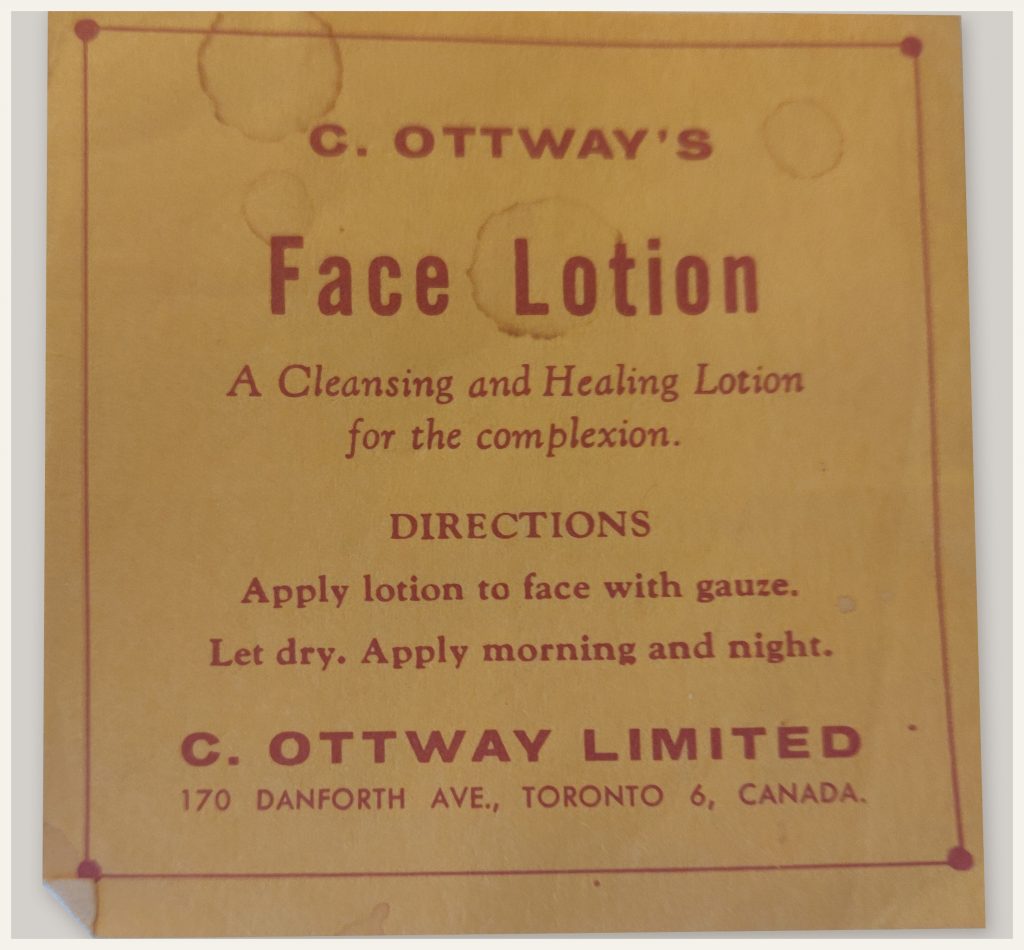
(Photos of these labels taken by Nick Faunus)
Mr Ottway became a popular and highly regarded Toronto character and was featured in the newspapers and on the radio. On one occasion he was taken to court for “illegally practicing medicine” but the public outcry against this was so great that the court summarily dismissed the charge, and he was never charged with anything again. Mr Ottway was also generous in his support of the poor and disadvantaged, giving free remedies and advice wherever it was needed.
Once, when he heard of a small boy suffering badly from boils, he offered to take care of him – and the boils cleared up in five days! After seeing the suffering that the poor boy went through, he vowed never to charge for the formula and gave it away freely to whomever needed it. The treatment consisted of only five capsules!
Along with Thuna’s (that’s another blog!) Ottways was the primary source for herbs in Toronto, up until the early eighties. Mr Ottway died peacefully in his sleep at 70 years but the products were still being made by his assistant Mathew Cameron, until he retired in the late eighties. The business has changed hands several times since then and still exists in a different location, but is still on Danforth Avenue. However, the unique products are gone and are no longer made there, although the store carries a wide selection of modern high quality products.
A personal note …
Mr Ottways story appeals to me for many personal reasons. I too arrived in Canada with nothing but my bag of herbs, and had to go out on the streets to sell them, in the early eighties, to live and eat. It was a struggle at first though always fun and fulfilling, but like Mr Ottway I never doubted the power of the herbs and my faith in them was rewarded many fold.
Most importantly I met my wife there in 1984 (she was working in the dispensary in the back). She heard me talking to the owner about some herbal products I was hoping to sell and caught me on the way out. She barely spoke but handed me a piece of paper, which I looked at when I arrived back at my rented room. It was her phone number, and we were married within a year! This year marks our 36th anniversary.
Isn’t it amazing what herbs can do for you!
We are always interested in learning more about Mr Ottway (and other past herbalists). If you have a story about him please get in touch with us here at hello@everythingherbal.ca!
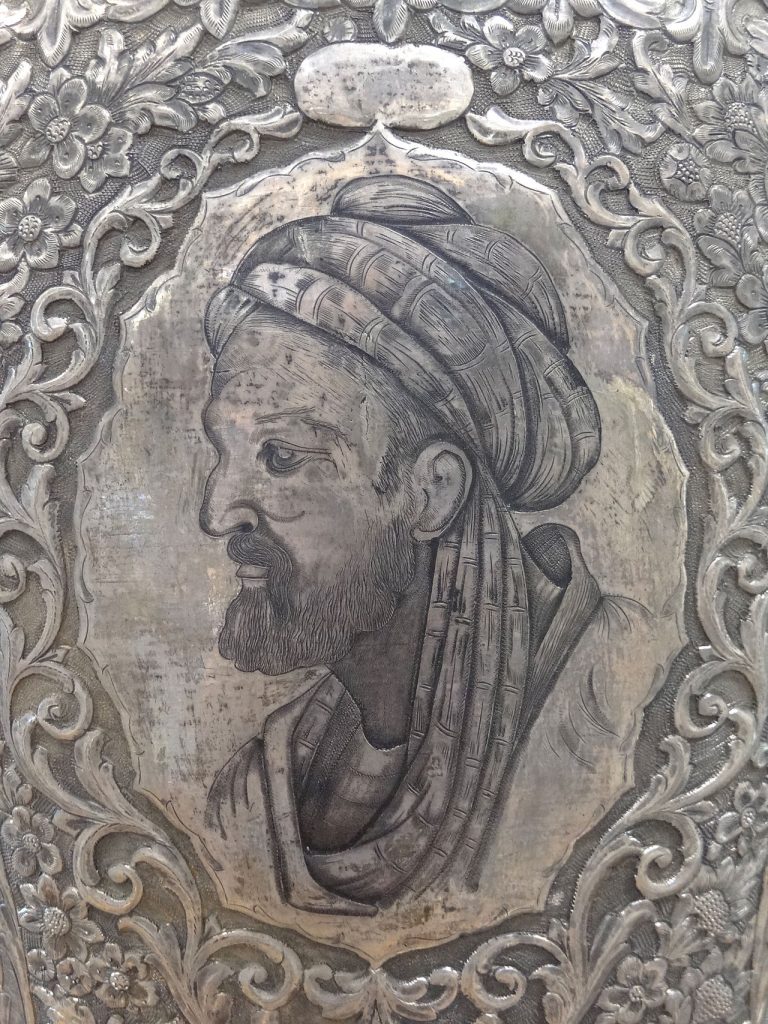
The Prince of Physicians
by Chalid Ottway.
In the region of Ibn Mansur, Amir of Bokhara, Arabia, in the year 980 A.D., in the town of Afshena, the first son of the Collector of Taxes was born. This boy, Abu, Ali Al-Husain lbn Abdallah lbn Sena, whom we shall call by his better known name, Avicenna, was destined to a career of undreamed of brilliance. He was to give to mankind new and superior methods for the prevention and treatment of disease that were to revolutionize the standard practices of his time, and to leave behind him the illustrious title. Prince of Physicians.
When Avicenna’s younger brother was born, his parents moved to Bokhara, which was then the chief city of the Moslem world, famous, even before its conquest by the Saracens, for its culture. Here, Avicenna was placed under a noted tutor, and soon proved himself a most precocious student. At the age of ten, he had not only mastered the Koran, but the Arabian Classics as well, and his tutor made no secret of the fact that the position of pupil and teacher was now reversed.
With an ambition that brooked no denial Avicenna continued to study medicine, astrology and kindred subjects, under the tutelage of the wandering scholars who, at that time, made their living by attending the sick and imparting their knowledge to the younger men. It was not long before Avicenna discovered that in most cases, his so-called teachers were nothing more than charlatans, or that his own learning was far in advance of theirs.
Aided only by the written works of others, he continued to study the higher branches of the Arts, and assiduously put into practice his medical knowledge. History records that he read “Metaphysics by Aristotle” forty times in an endeavour to fully understand this ponderous work, but in spite of this continual reading, its meaning remained hopelessly obscure, until for a few cents, he purchased a commentary written by Farribi. With this simple little aid, he obtained a complete mastery of the subject matter contained in Aristotle’s works.
At the age of sixteen, he had mastered medical theory and according to his own accounts, perfected his methods of treatment and preparation of remedies by continual attendance upon the sick without charge.
At the age of seventeen, he was appointed Chief Physician to the Amir, after having cured him of a dangerous illness that had baffled the noted doctors of the time, and was further rewarded by being given access at all times to the wonderful collection of books in the Royal Library.
A few years later, the Library was totally destroyed by fire. Avicenna’s enemies accused him of arson, saying that it was his intention to conceal for all time the sources of his marvelous powers and learning. This contention, however, was never proved.
All through the period in which Avicenna lived, his country was riven by feuds and war. In the year 1004 the Saminid Dynasty came to an end. Declining the offer of the position as physician to Mahmud the Ghasnivia, he began his wanderings from town to town in Khiva and Khorasan seeking an outlet or market for his talents.
During the siege of Darlem, in 1012, Avicenna suffered so from privation, that he was taken seriously ill. When he recovered, he sought the assistance of a friend and settled in Joryan, near the Caspian Sea. There, he lectured on logic, astronomy and medicine, and wrote several treatises, in addition to commencing his famous “Canon of Medicine”.
The constant feuds of those in power, forced Avicenna to travel west, and he stopped at Rai, in the vicinity of modern Teheran. Eventually he settled in Hamadan, where he continued his prolific writing, completing thirty more of his works, and his Canon of Medicine, comprising in itself five volumes, which were dictated and explained to his pupils day by day.
He was consulted by the Amir who afterwards appointed him to the office of Vizier. This appointment caused much jealousy, and roused Avicenna’s enemies to plot against his life. An order for his execution was signed by Shamus Addaula, and Avicenna was forced to hide in the cellar of a Sheik’s house for forty days, at which time a pardon was obtained by royal command in order that he might attend the Amir who was very ill.
War, prison and privation, coupled with the intense mental strain of overwork, punctuated by strenuous bouts of material pleasures, undermined Avicenna’s constitution and depleted his stamina.
During one of the ever recurrent campaigns, he was seized on the battlefield with a serious stomach trouble. He applied to himself remedies that were so strong that he had to return to the city. A similar seizure at a later date warned him that the disease was gaining ground. He resigned himself to his fate, realizing that his weakened system could not stand the arduous regimen necessary to check the disease.
With characteristic thoroughness he bestowed all his goods upon the poor, and freed his slaves. The latter part of his days was spent in listening to the reading of the Koran, from which he derived much comfort, and thus in the month of June, 1037, Avicenna passed from this world. But the works of this Prince of Physicians lived on, and became the guides to the medical study in the European Universities from the twelfth to the seventeenth century, and are again, in the writings that will come*, carrying on their task of enlightenment and mercy.
A Note on Pronunciation
It is felt that it is wise to give here a literal translation of Avicenna ‘s name, since the one with which we are familiar is in reality the English corruption of his Arabic nickname. It is well to keep in mind too, that each Arabic word has several meanings, so that a word may appear in its translated form at one time in one manner, and at another in different manner.
Abu Ali Al-Husain lbn Abdallah lbn Sena
Abu – Title of respect such as our Sir.
Ali – His father’s given name.
Al – Roughly translated, in this case means, of.
Husain – The Persian calling of the family name, which is in Arabic, Nesaif.
Ibn – In this case, means son.
Abdallah – Avicenna’s given name.
Ibn Sena – Son of Abyssinia, or coming from Abyssinia.
It was by this name that our Doctor and Philosopher was known, that he might be distinguished from others of the same family name, and it is from this nickname, Ibn Sena that the English corruption, Avicenna comes.
So, literally, we have Mr. Ali Al Husain’s son, Abdallah, who comes from Abyssinia.
*Note: I intend to feature extracts from Chalid Ottway’s writings in future blogs, including some of his wonderful formulas!

